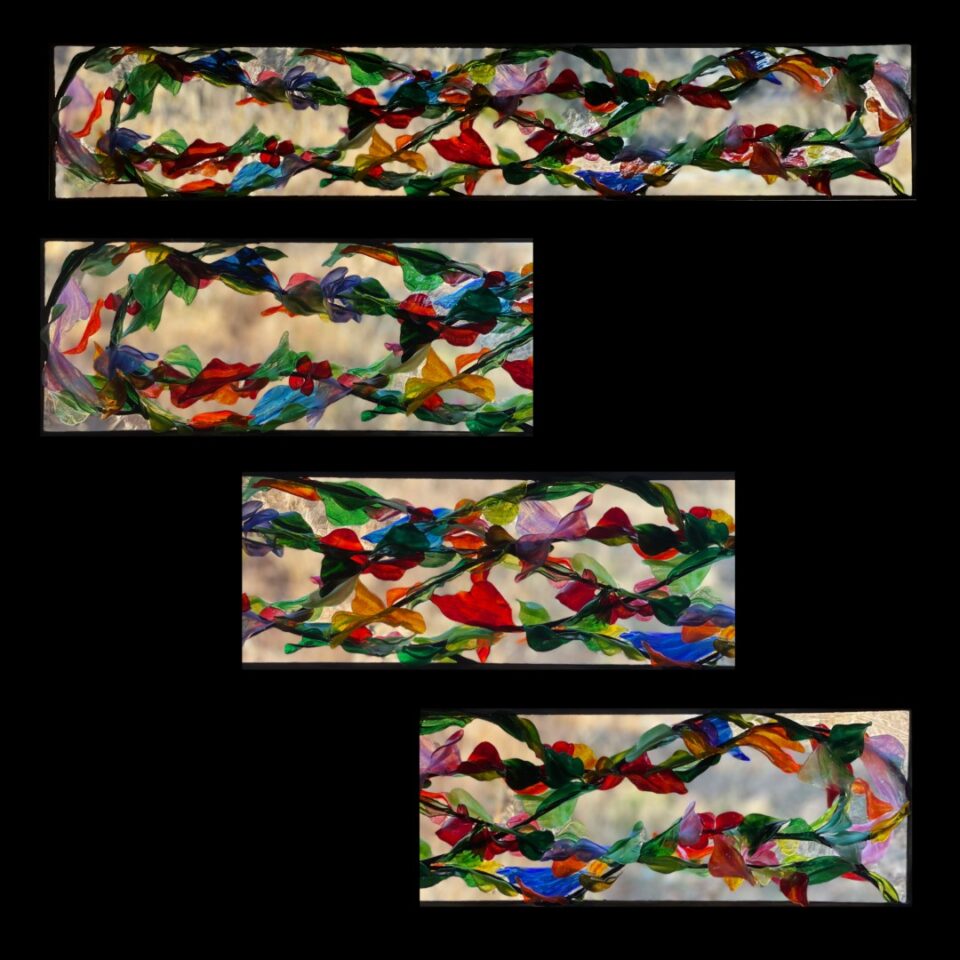
It’s always somewhat of a sad day when a project leaves our studio – especially this one.
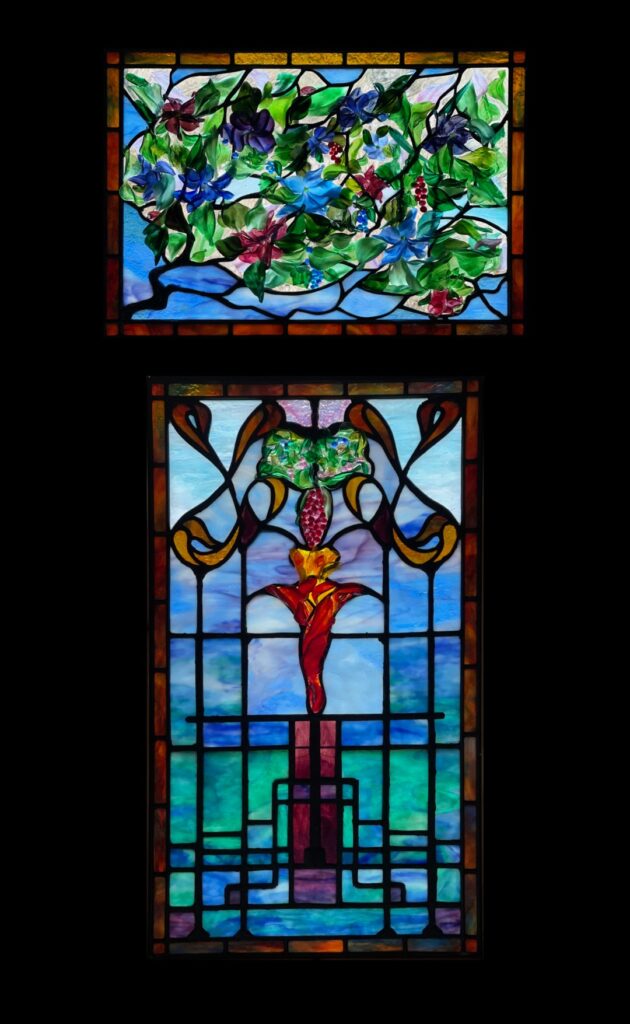




A pantry door and transom for a home in the historical Fan District in Richmond, VA.
Our goal was to create a garden gate effect with the garden above, merging into the top of the gate. If you look at the details in the close-ups, you can see how the solder sculpturing on the door creates the effect of rusted iron.
Our flameworking provides the 3D effect we wanted, through the manipulation of light and shadow.
Wishing everyone a wonderful Thanksgiving!
It’s been almost 50 years since I started working with glass.
Starting on the kitchen table, I made window ornaments. Apples, pears, cherries, chickens that stood on one leg……
I still do most of my conceptualizing on our kitchen table, mostly between the hours of 2 and 4 AM.
I cherish these 2 hours. No interruptions, my defenses are down, allowing for my best “free association.”
You may notice this photo was taken early in the morning. I’ve been married long enough to know that waking my wife up at 3 AM in the morning to take my picture is not a good idea.

Doing and thinking, thinking and doing………….
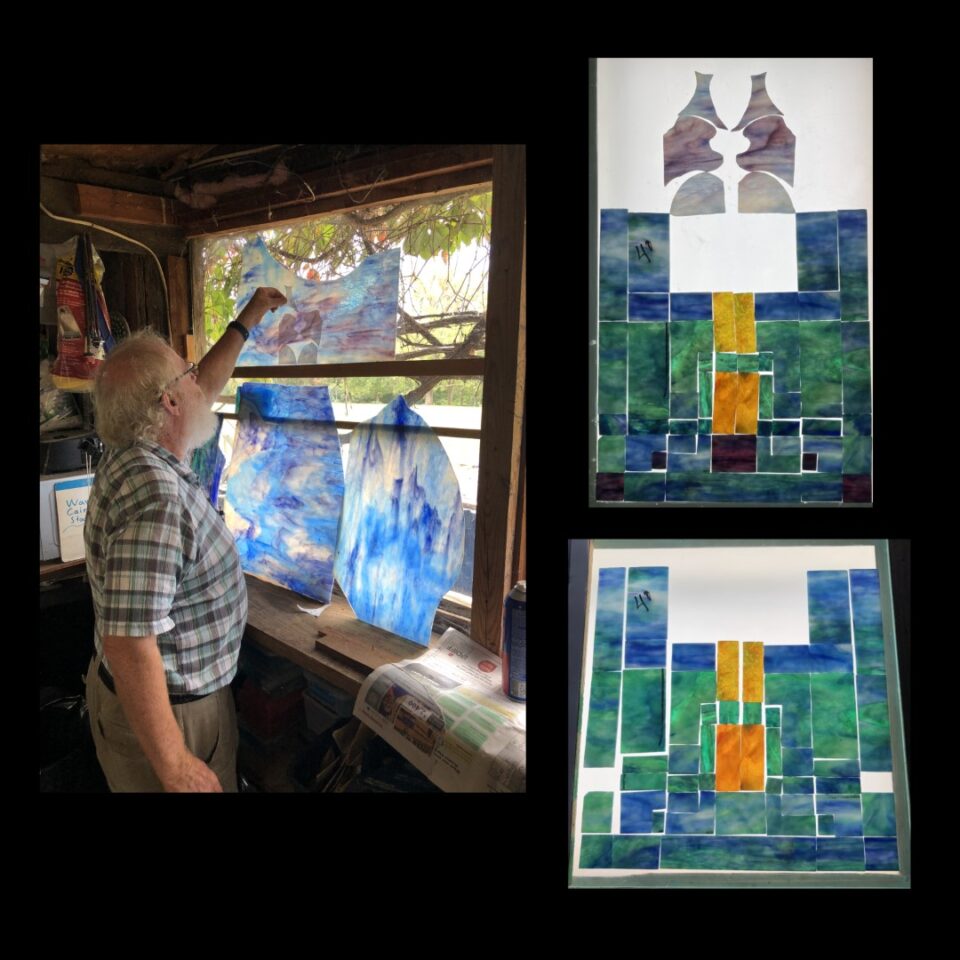
The evolution of our window, Part 2.

The color selection begins……


Daniel, my son, who is the painter, took the lead role in the project – both designing and painting. This window was commissioned for a historic home in Crewe, Virginia, to complement the finished renovations. Painted on completely transparent German mouth-blown glass, this window allows the room to remain light while creating a jewel in this home.



When it’s your 6th Birthday and grandpa is a craftsman…………..

One of my fondest memories as a kid and life-changing, was when I was around six years old. My father and I were home alone on a Saturday and we decided to have Campbell’s Tomato soup for lunch. After emptying the contents of the can into a saucepan to heat over our kitchen stove, he poured a half can of milk in and started stirring.
As I observed this culinary experience from the mind of a six-year-old, I pointed out to my dad that the instructions on the can called for a full soup can of milk.
“I think it tastes better with a half can. You don’t always have to follow the directions.”

I’m quite fond of Lambert’s glass, having used it in various projects for over 45 years.
I find the making of glass quite interesting, silica, lime, soda, and metal oxides, heated to around 3000 F. But what really fascinates me is how this molten material is made into sheets of glass.
In an age when most products are mass-produced using computers, artificial intelligence, and robots, Lamberts continues the time-honored tradition of glassblowing. This gives the glass its “character” through the use of texture, bubbles, and striations in hundreds of colors
.I find myself in almost a state of reverence when working with this beautiful material. It inspires me to do my best as I continue it’s journey into a work of art.


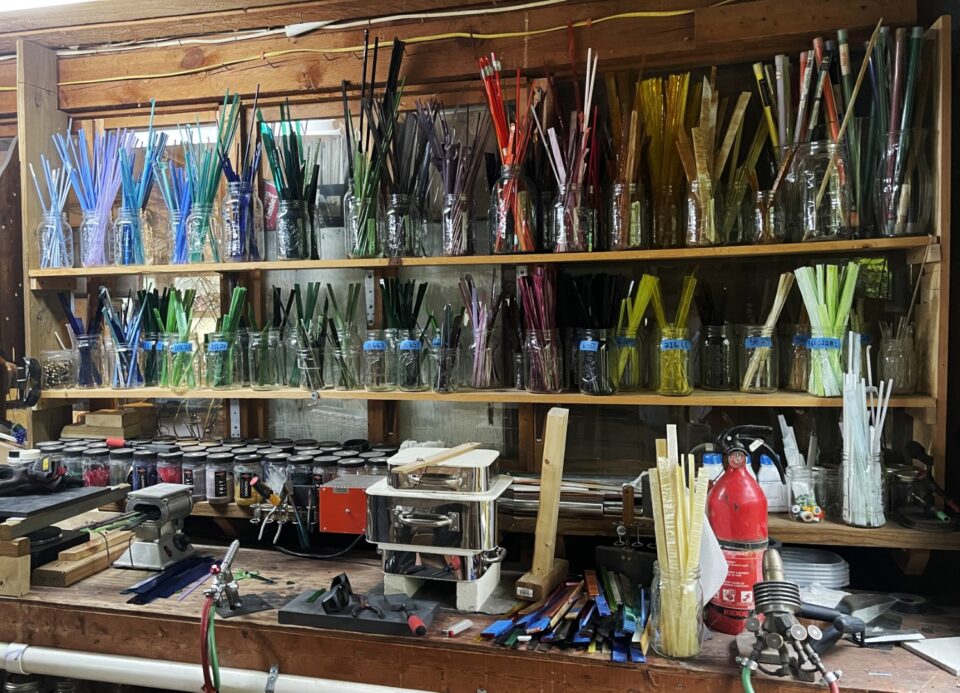
Buying stained glass has changed over the last several years.
It used to be we had to buy a whole sheet, gather together enough colors to make crating and freight cost worthwhile, and usually waiting several weeks before it arrived. Now, our suppliers cut the sheets into smaller pieces, box, and deliver by FedEx and UPS.
This has greatly expanded and reduced our cost of building a wide color palette.

Thank you, friends, for your comments on my last post:
“To border or not to border.
To iridize or not to iridize.”
Often we are challenged with the question, “Whose art is it?”
As we absorb information from our environment, making it accessible to our subconscious, then bring it back to life in the form of a work of art, I believe that art is the individual’s expression, their creativity, and the work of the artist.
To border or not to border.
To iridize or not to iridize.
I remember reading somewhere, many years ago, someone’s definition of creativity was the “constant reorganization of new information.”
Maybe so.

As I was designing this window, I gave considerable thought to how I would tie the two main design elements together, the iron garden gate in the lower section and the grapevines with morning glories in the transom.
After considerable sketching, I came up with the idea of the sculptural form in the middle, adding yet another design element. Then, it occurred to me to design the top of the sculpture as if it was a young bird in its nest, being fed by one of its parents.
Including the stylized “baby bird” ties everything together while giving the window a mystery element, a conversation piece, or in design terms, the Wow factor.

I consider my work a collaboration between artist and client. Over the years, my autonomy in these situations has grown to the point where I ask my client to review my website and give me a direction they would like for their project. Then, I take the opportunity to expand on my previous work. I consider this a form of funding for my development as an artist.
It’s rare that significant changes are made, mostly a slight adjustment to surrounding colors, lines, and shapes. I consider blending my work with its surroundings as part of my art.
There are times, I wonder if working with people is as much a part of my art as the creation of a window. I remember one project, around 25 years ago, where after creating four windows for a couple’s historical home, they informed me “we’re going to Vail, please make us a window for this opening, and send us an invoice.”

After shuffling some graphite around on a piece of paper, I came up with this design for a pantry door and transom. It’s for one of the large, old, beautiful homes in The Fan, in Richmond, VA.
I’m going down for a visit this Sunday to review some color samples to see how they work in the opening. There’s a small window in the back, that lets in a little bit of daylight, which may give us exactly what we need. However, “I never know until I see it.”
By the time we design, select glass samples, and have the approval from clients, we are usually halfway through the project. Even after starting the project, I’m free to make slight changes as I see how the materials work together.
I’m very proud to carry on the tradition of the Artist/Craftsman. It gives me great satisfaction to see my work, often as a focal point of architecture, and know it is the result of my creativity, developed after almost 50 years.
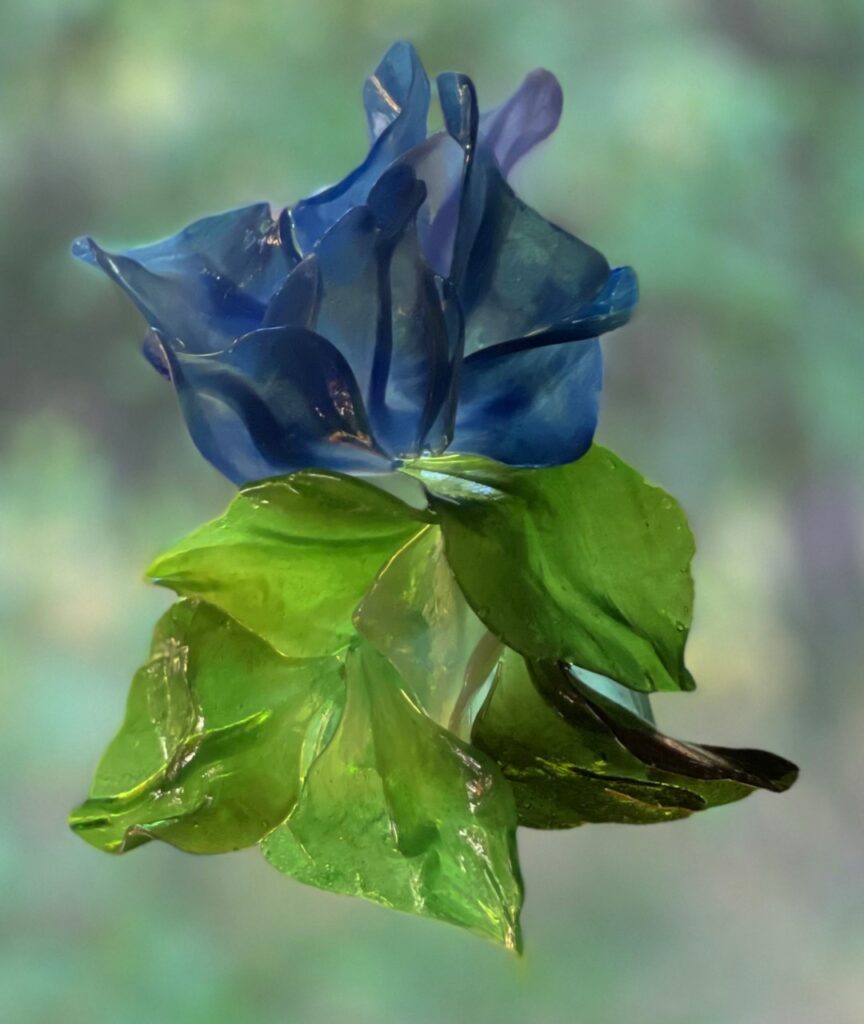
We just made this study a few minutes ago for a couple of commissions we are moving forward on.
Will and Scott have become such experts at flameworking. My job is to conceptualize the window and then arrange the pieces.
We often hear the word “team,” for people working together. It is actually the perfect description of what goes on in the creative process. However, it makes me feel like I’m working at Microsoft, Amazon, or Apple. My preference is to refer to my coworkers, as “Gentlemen.”

One of my most memorable commissions, the Billy Ireland Cartoon Library & Museum at Ohio State University.
Working with great people contributes greatly to a successful commission. Here I had the rare opportunity to be the support person while my son Daniel White took over most of the conceptualization and all of the painting.
Painting cartoons is a long way from painting church windows. Combining the subjects with the complexity of painting on glass with all the different firing temperatures, organizing the different layers of paint was quite a challenge for a twenty-six-year-old self-directed artist.
Made for a very proud papa.
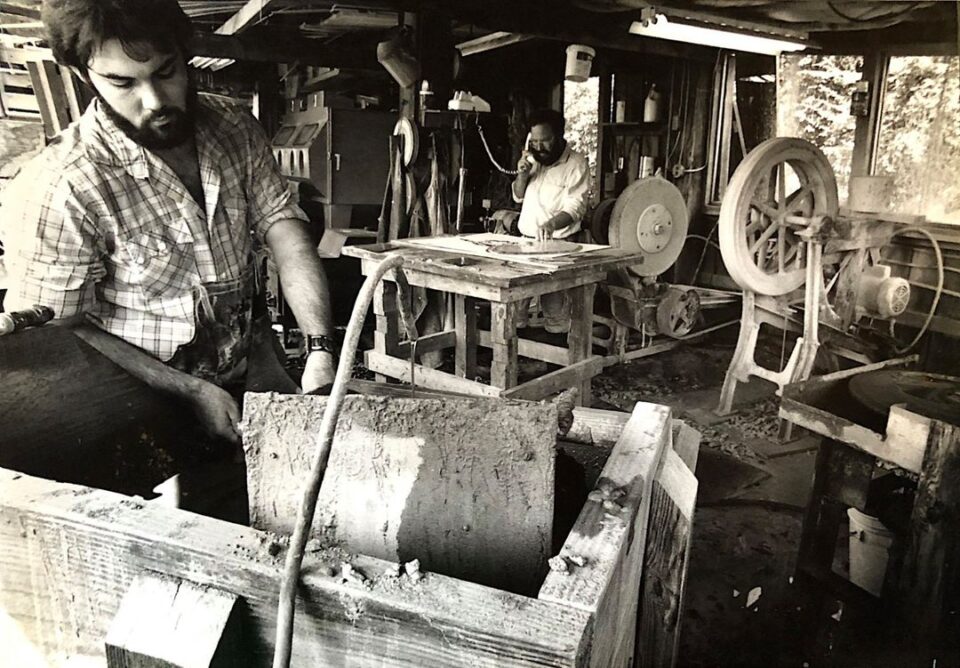
This photograph was taken in 1985, obviously before cellphones. If one was to take a photograph today, the only difference would be the phone.
John was around 17, and I was around 36.
If you look closely, you can see the snow outside the window and know that the wood stove was crankin’.
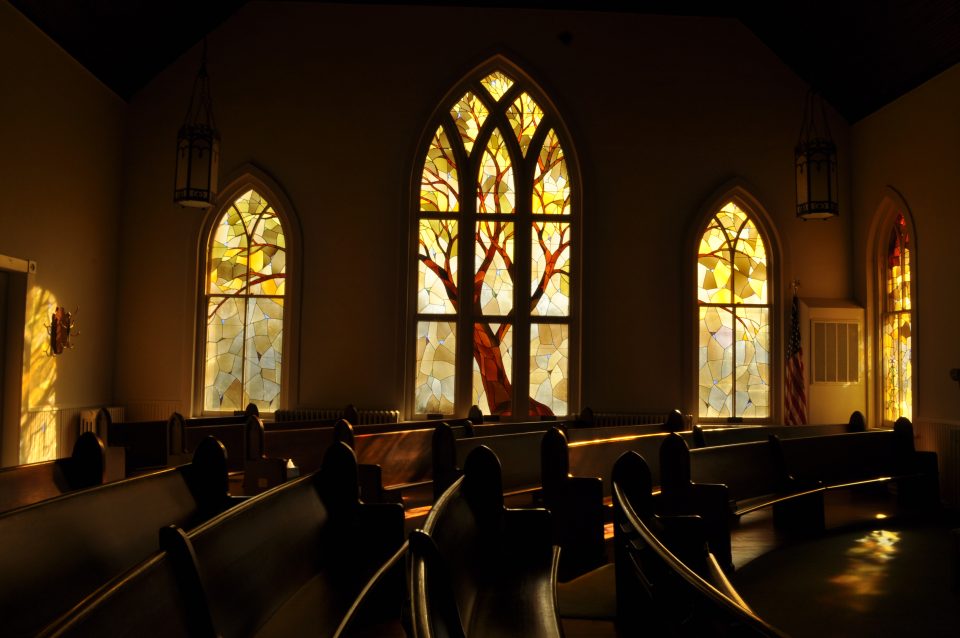
This is the first church I worked with, Amelia Presbyterian in Amelia, Virginia.
I was 27 years old, working in a studio I built behind our home in Richmond, Virginia. At the time, I was doing small residential windows, lamps, and some restoration work.
Two members of the church approached me about working with them to create windows for their sanctuary. “We know we don’t want traditional windows, but we also don’t know what we want.” I visited Amelia and found their church nestled in a grove of old oak trees. Many in the congregation were in the logging business.
I presented them with an idea of what I believed tied together their passion, aesthetics, and spirituality.
Over the years, I have been surprised by how often this pattern of how people found me has been repeated. After sending out letters of introduction, postcards of our work, and making “cold calls” I still find that most of my more interesting commissions have come to me from “out in right field,” often by word of mouth. One of the most flattering surprises is when someone will contact me who read an article about my work, kept it in a drawer for ten years, and brings it with them for our first visit.
It’s almost impossible to know how one is perceived beyond our own consciousness. But maybe, in part, it’s the mystery, the euphoria granted me from these experiences that nourish my soul and keeps me moving forward.
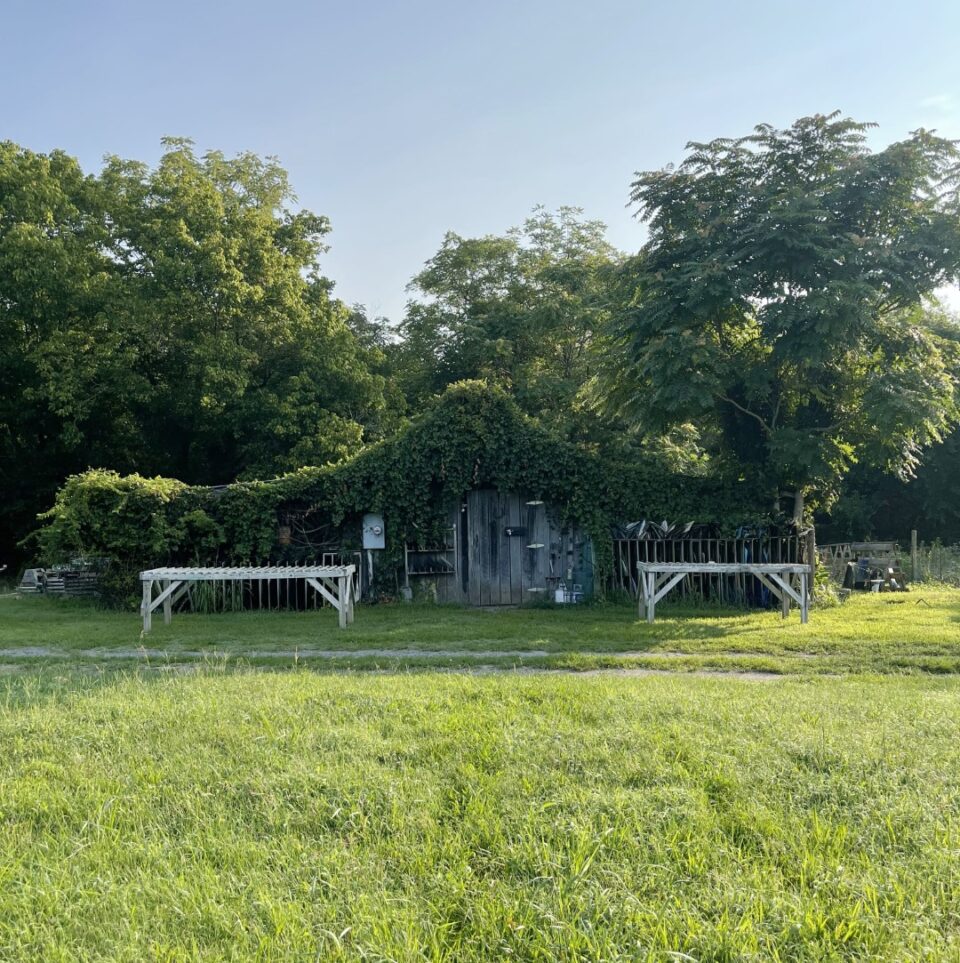
Thirty-five years ago, I chose for my studio an old barn on our seven acres, just 900 feet from our home.
A tin roof, wood stove, windows along all four sides, and room to work outside have endeared me to this precious structure. I can nail the tools of my art up almost anywhere, build a temporary easel for a work in progress and move tables and lighting fixtures around at will. I love the feeling of the changing seasons, being freed from the thought of having every cubic inch of space within a narrow temperature range, twelve months a year. And the best part is I can wear my Good Will clothes until they are ready for the rag pile, or “mysteriously” disappear from my closet. I have always disliked new clothes, preferring to dress somewhere between “old money” and people who work the land, mines, and shipyards. Here, our “dress code” makes casual Friday look like prom night.
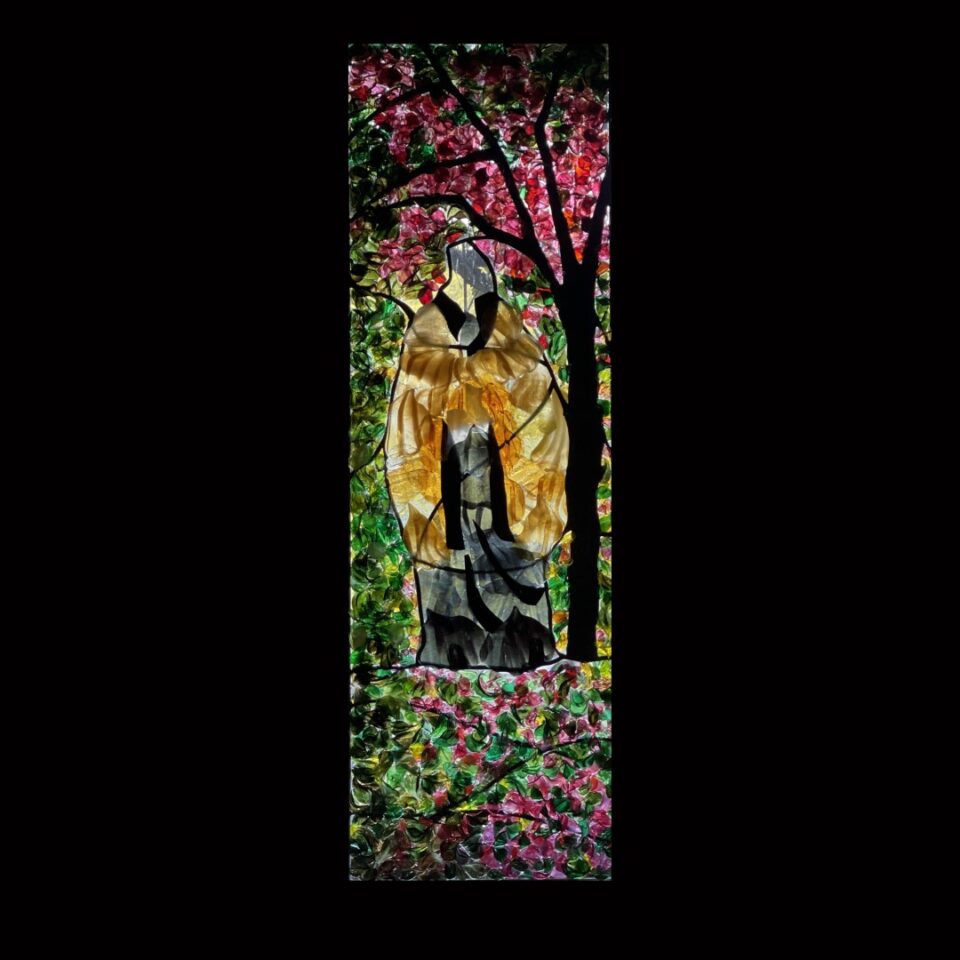
The making of Confucius.
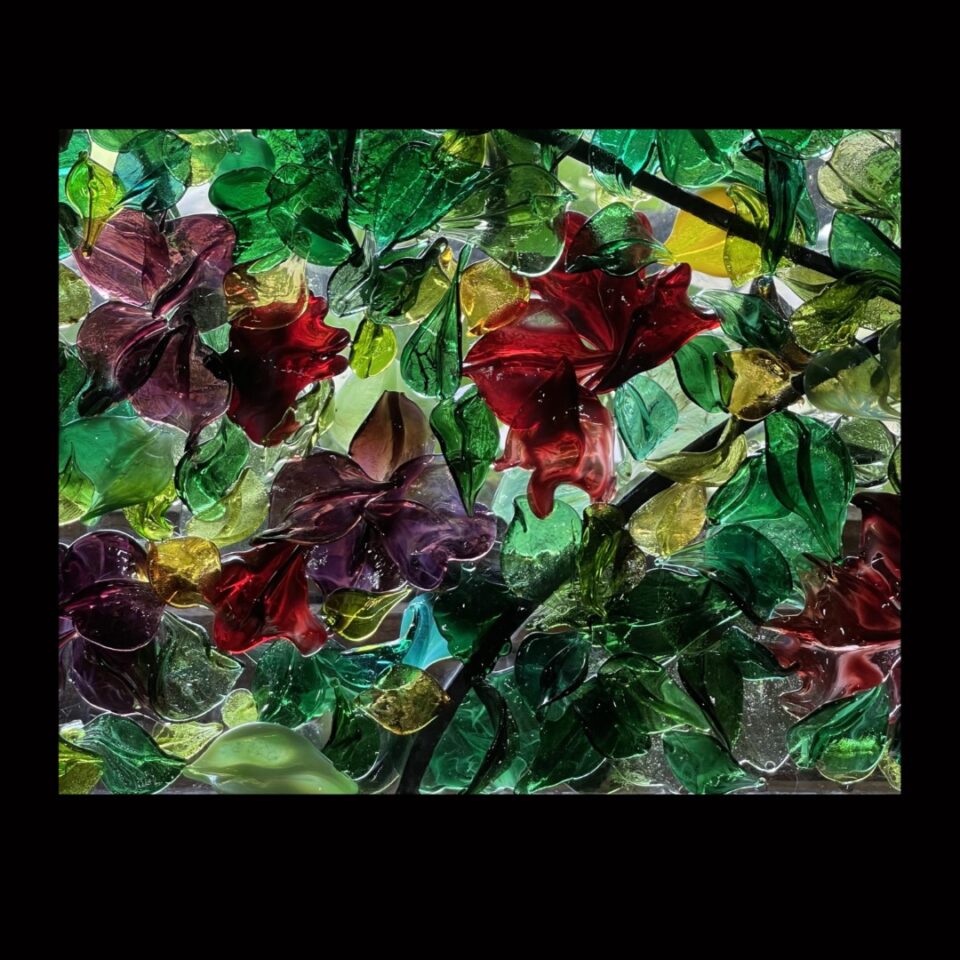
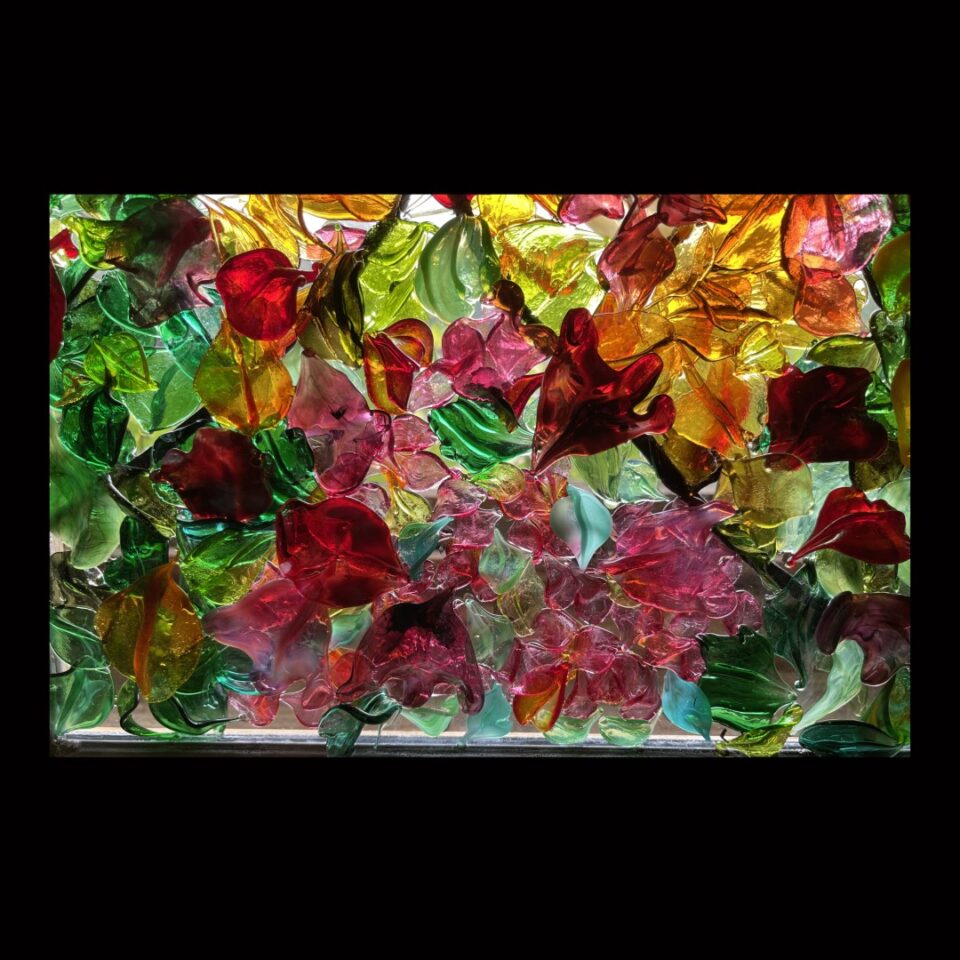
As we were finishing work yesterday, this section of Shanti kept “speaking” to me. I have looked at it at least twenty times since and I’m still mesmerized by its balance of complexity and harmony.
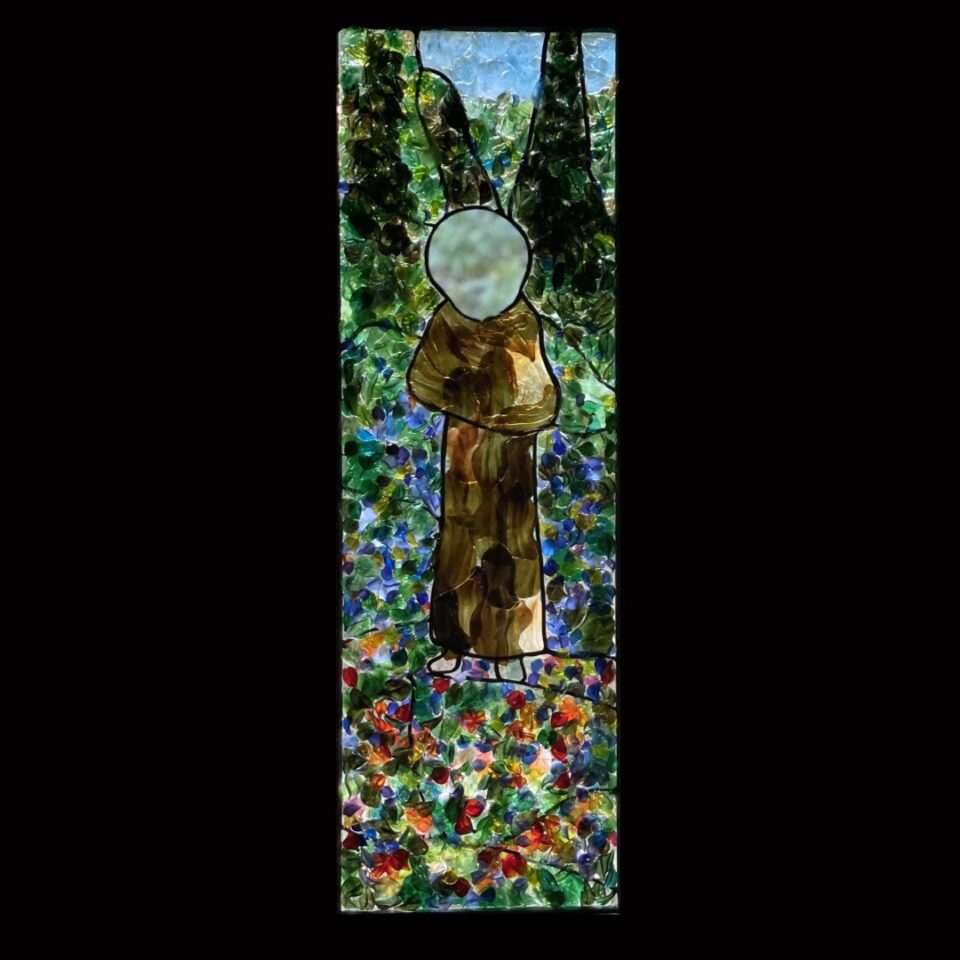
The blending of the figures for the eight Shanti windows has been joy around here. Much searching for the correct glass and manipulating it with our flameworking.
Or, as we like to say here in the studio,” Claude Monet meets St. Francis.”
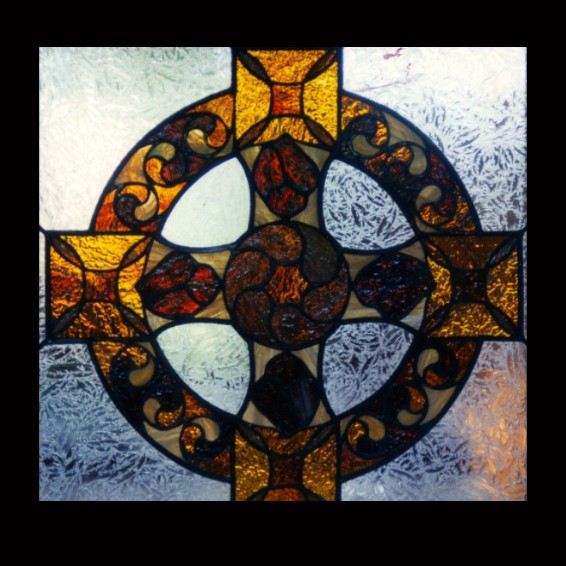
Another Irish window we created around 15 years ago.
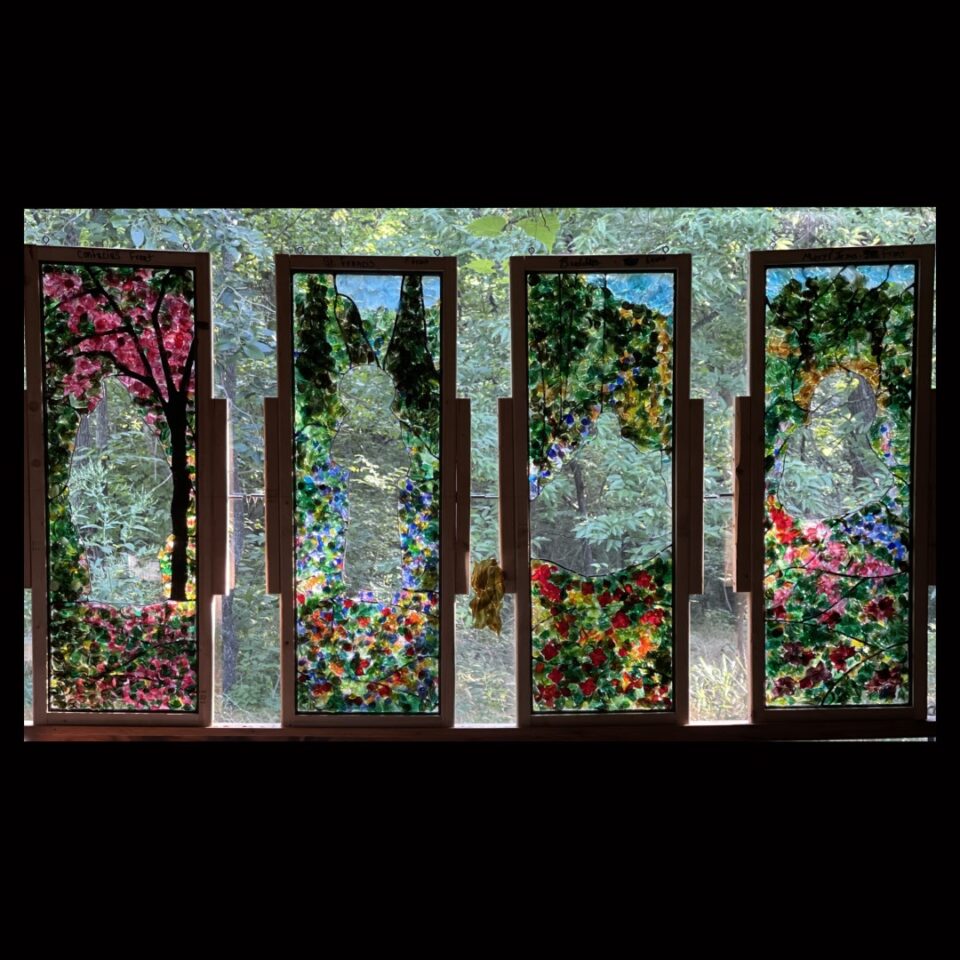
Four of our eight windows for the Shanti.
We are beginning to build the figures now, St. Francis, Confucious, Buddha…
If you look closely, in the center bottom, you can see the beginnings of St. Francis’ robe.
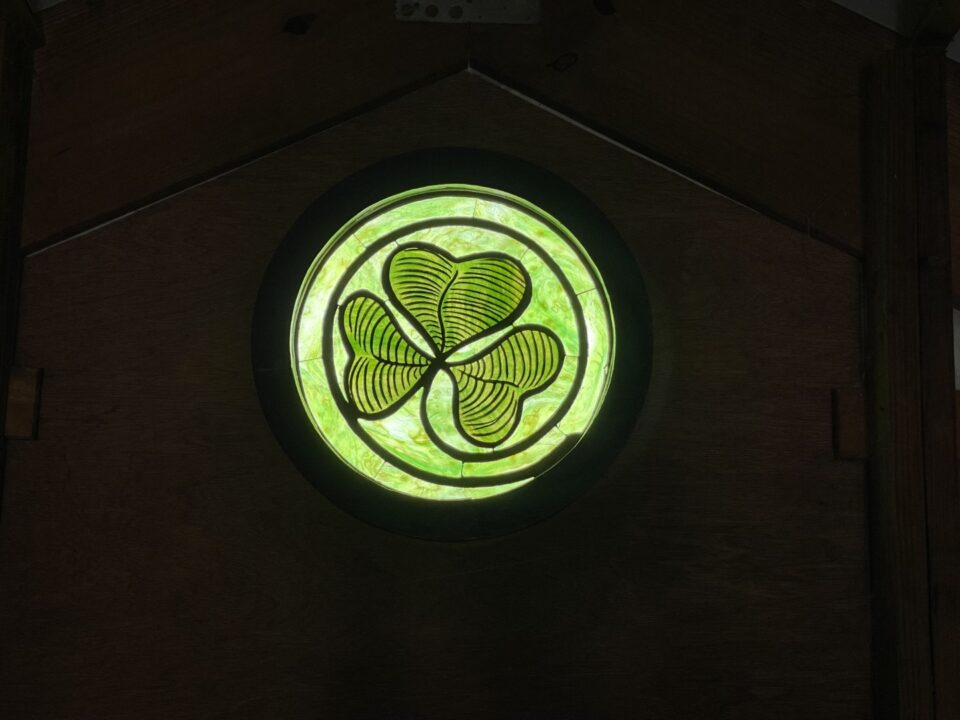
Around 10 years ago, we created this window for the peak of a horse barn on a plantation just down the river from us.
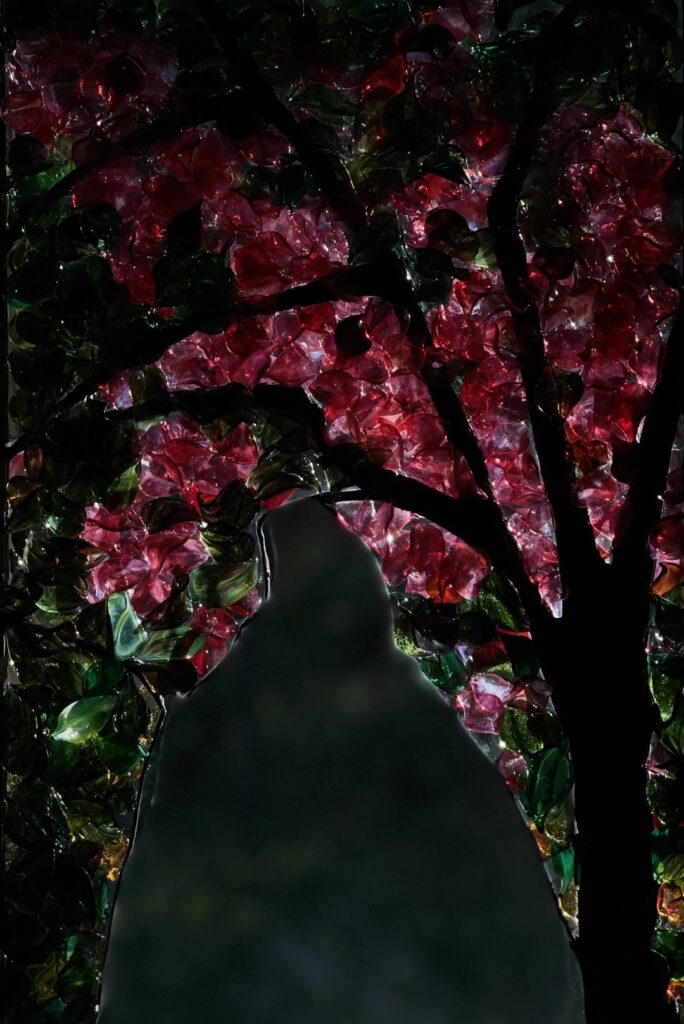
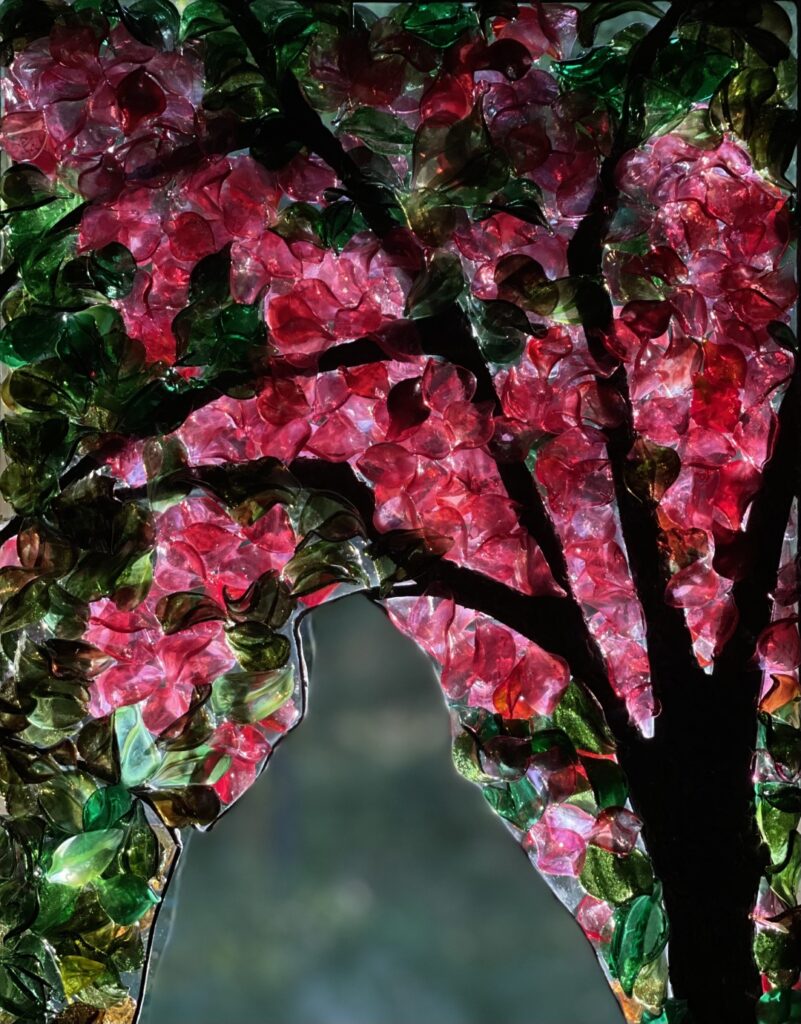
After 49 years of practicing my art/craft, I am finally realizing my goal of achieving the translucency of nature in my work.
This brings an enormous amount of satisfaction to me as I look back over the years and think of all of the experimentation and time it required to achieve what I now consider the pinnacle of my work.
Now off to explore my ideas for sculpture and three-dimensional windows.
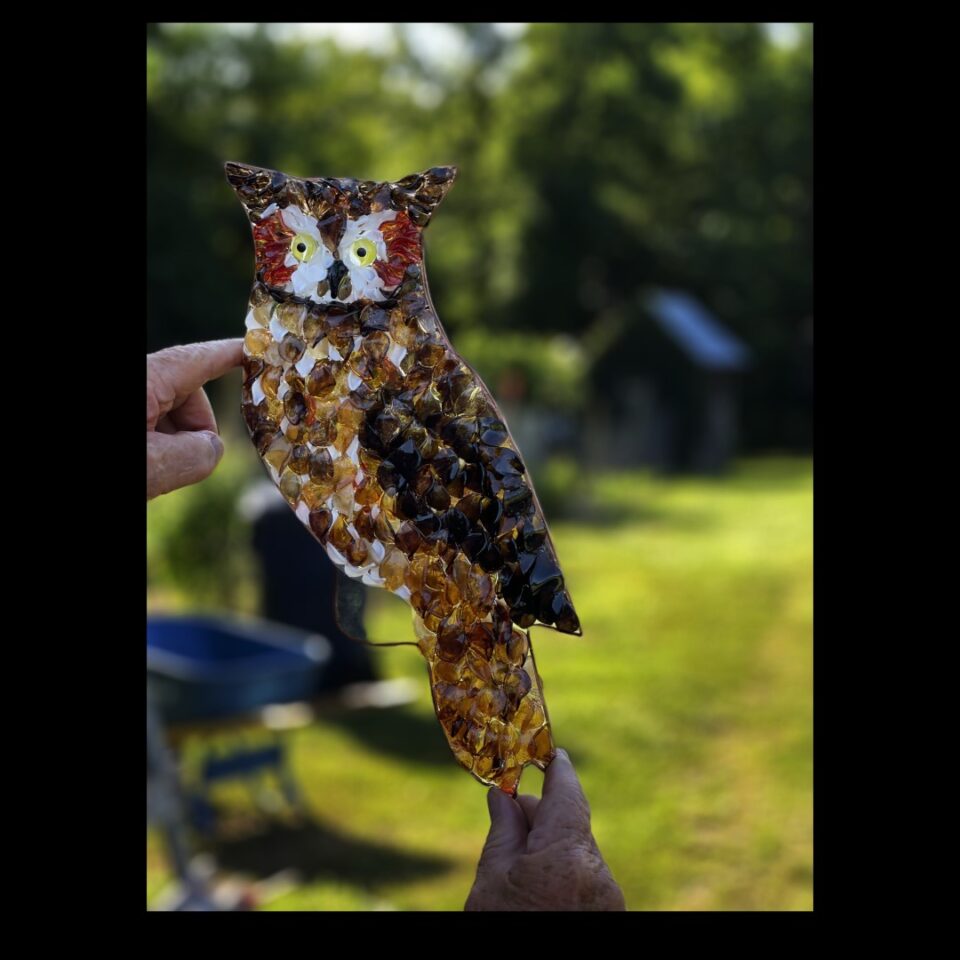
An accent piece for one of our windows.
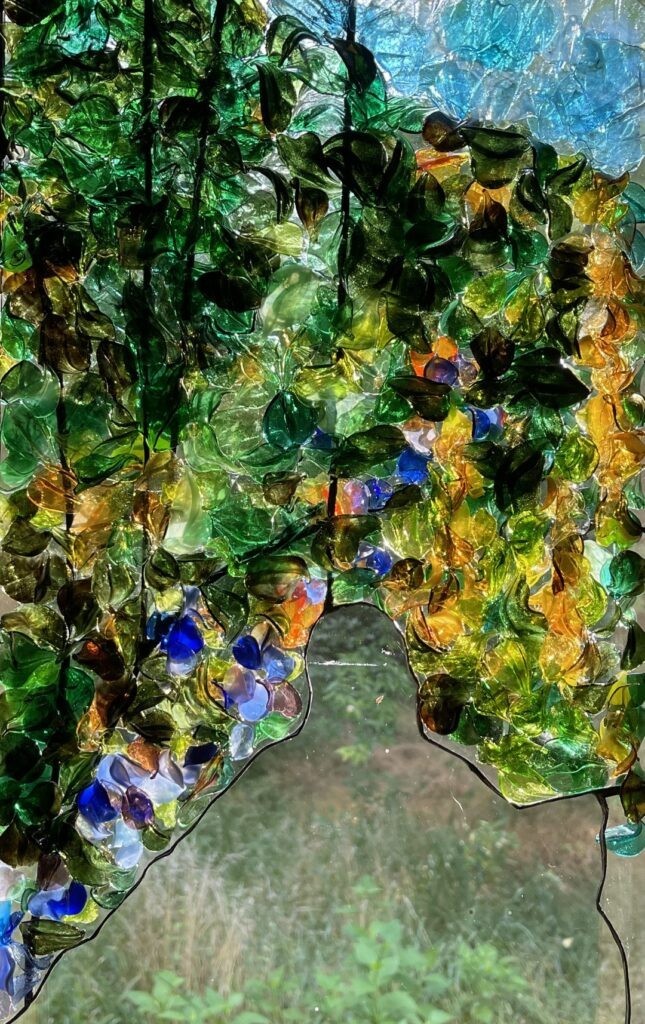
Capturing this morning’s sunlight.
As we move along on developing our “Painting with Glass” technique, we leave the windows to study in both Northern and Southern light. This gives us the time we need to study the glass from sunup to sundown.
This movement of light, combined with how the colors interact with each other throughout the day, creates what seems to be an endless learning experience. Which may explain why so many of us artist have a hard time “finishing” our work. This also supports why so many of us believe our wealth lies in our development, and not so much in our bank account.
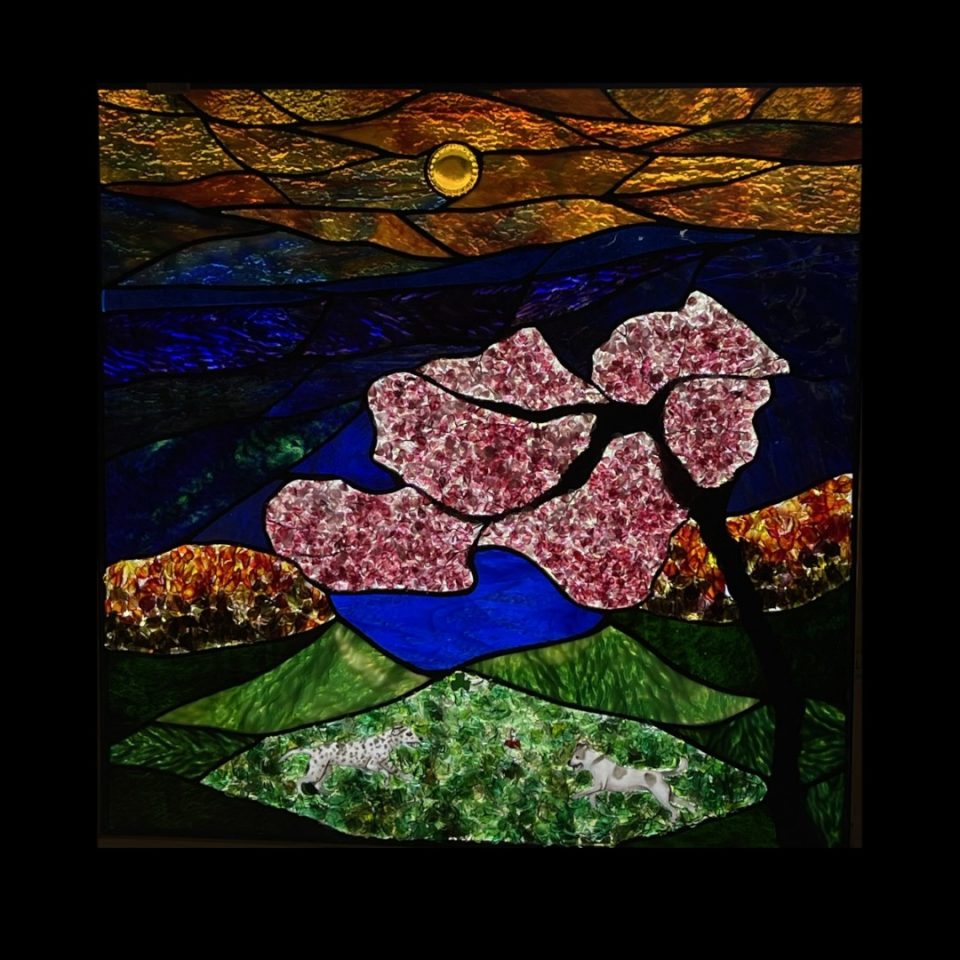
A recently completed commission in which I combined traditional stained glass techniques with our “Painting with Glass” to create a dramatic depiction of a fading sunset, casting shadows through the mountains while highlighting the translucency of nature in the foreground.
Another section from one of our commissions in which we use our “Painting With Glass” technique – inspired by impressionist paintings with the emphasis on light and color to create the illusion of depth and movement. By taking traditional stained glass and working it over a flame, we are able to create various shapes and thicknesses to control the light as it passes through the glass.

Another section from one of our commissions in which we use our “painting with glass” technique – inspired by impressionist paintings with the emphasis on light and color to create the illusion of depth and movement.
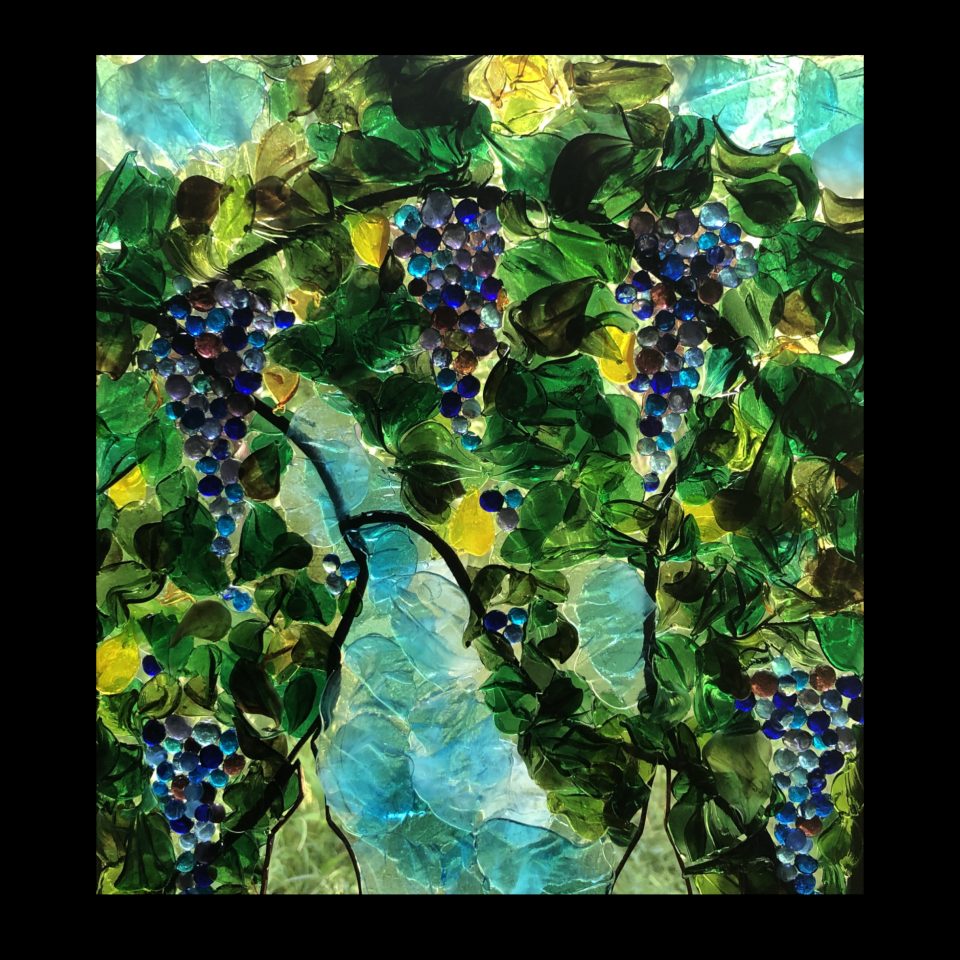
Our most advanced project to date, using our “painting with glass” technique – inspired by impressionist paintings with an emphasis on light and color.
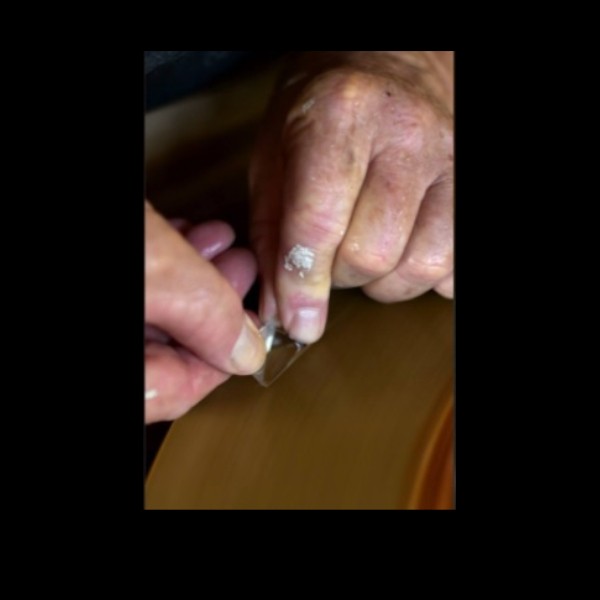
Resisting the pressure of rotating iron, stone, cork, and felt as one grinds and polishes, is like Gold’s Gym for your hands.
Many years ago I stopped off at a plumbing supply store to purchase some solder. Discovering I didn’t have my checkbook, the owner smiled and said, “take the solder and mail me a check. I know you’ll pay me, I can tell by your hands.”
As a kid, my mother would tell me I had fingernails like a girl. But that’s another story.
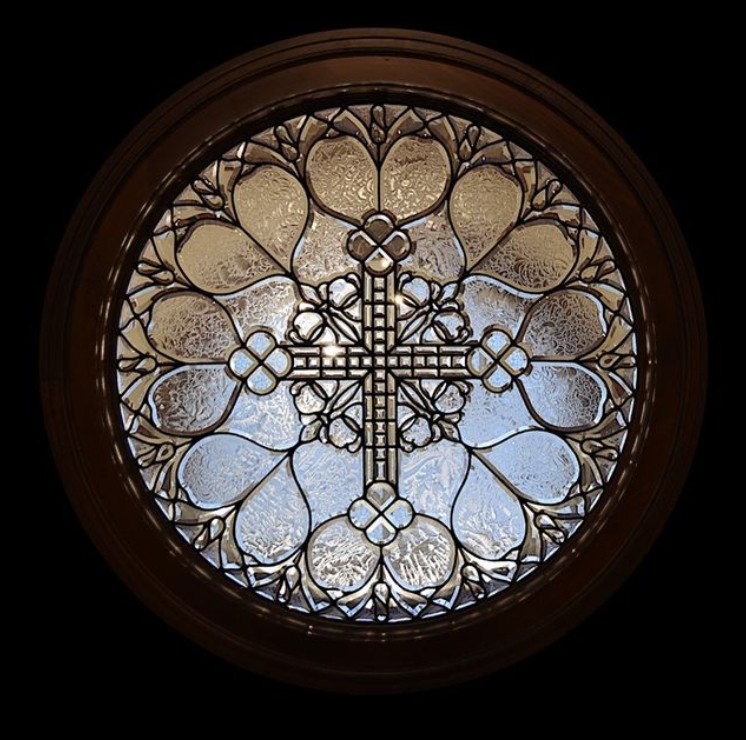
One of my favorite windows.
I designed and beveled the glass on my 1915 Henry Lang beveling machines, around 30 years ago.
Hand beveling on rotating iron, stone, cork, and felt, creates the minute, multiple bevels that give the overall window its character. I consider this the equivalent of woodworking with hand tools and to the beautiful craftsmanship of blacksmiths.
Over the course of my 48-year career, this character that comes from handcraftsmanship, is perhaps what I am most proud of.



Over the years, we’ve strived to incorporate a more natural look in our windows, especially our branches, by eliminating reinforcing bars that created shadows through our designs.
We have achieved our goal by creating an internal structure of nails and reinforcing bars. Once secured, we are able to sculpture our branches, hiding all of the internal reinforcing structure.
Rain is pouring down on the tin roof, fire in the woodstove, everyone’s full of turkey, and happy to be back at work.
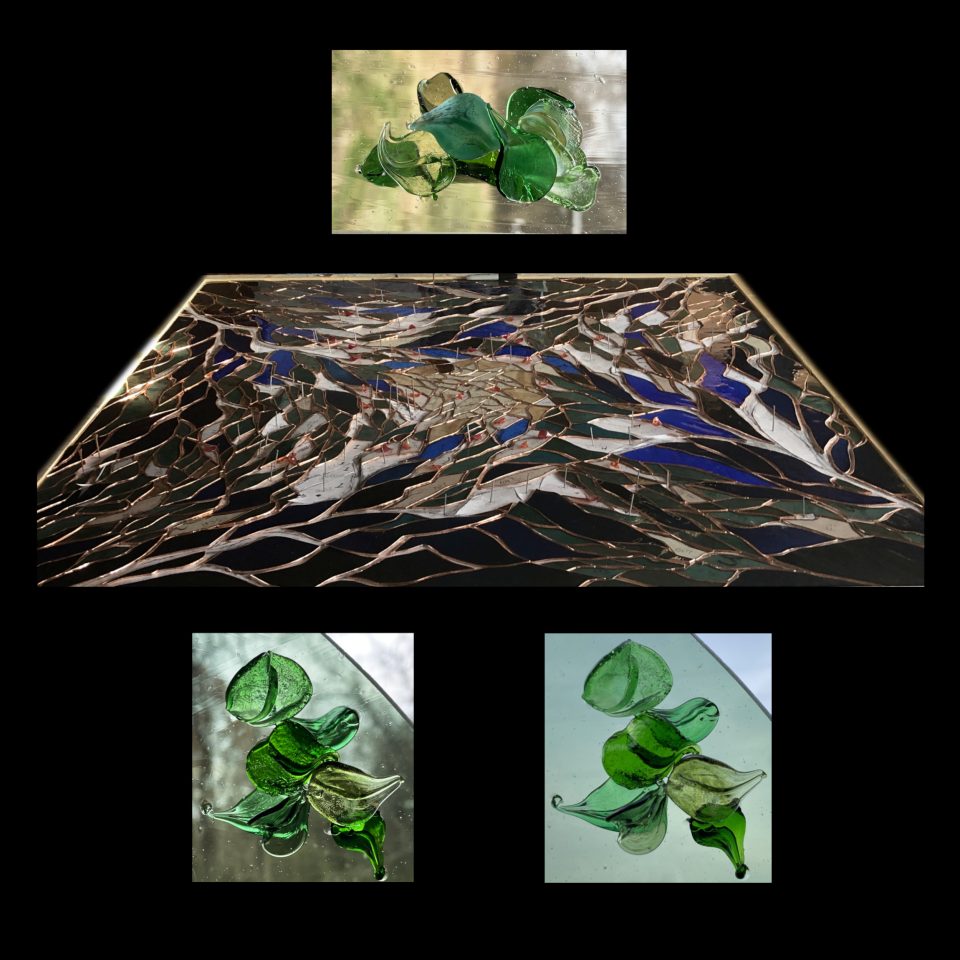
Every morning, around 7am, I unlock the door to my studio and enter my creative world.
There are almost always three to four projects in progress, two to three on the drawing table, and several that are finding their way between my conscious and subconscious.
One of the ways we manage this mass of information, to conserve our resources of time, labor, materials, and expenses, is to make studies.
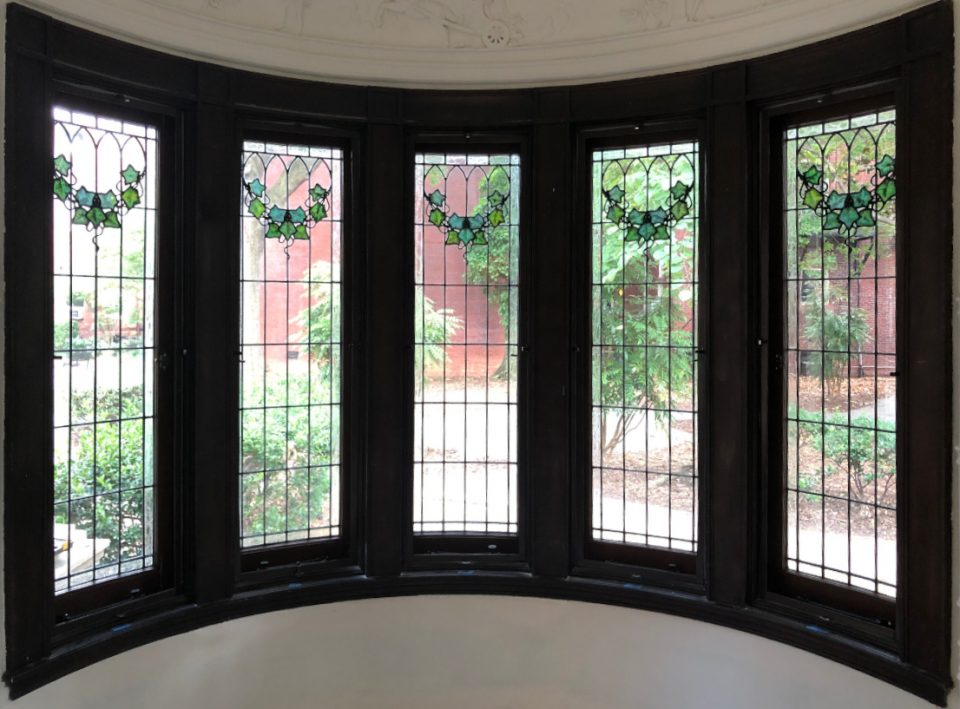
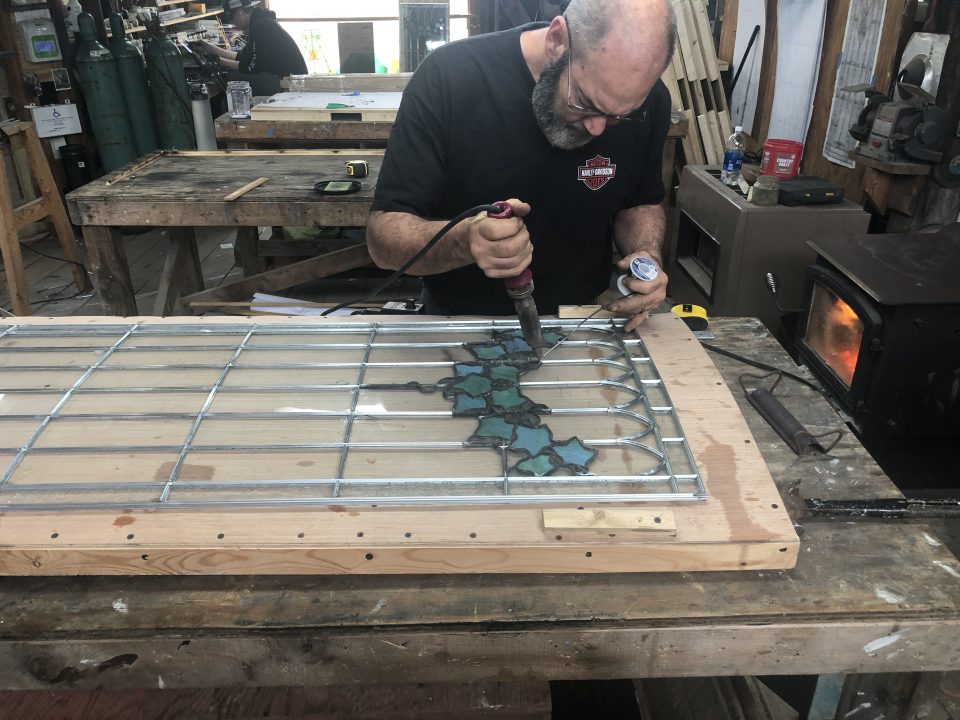
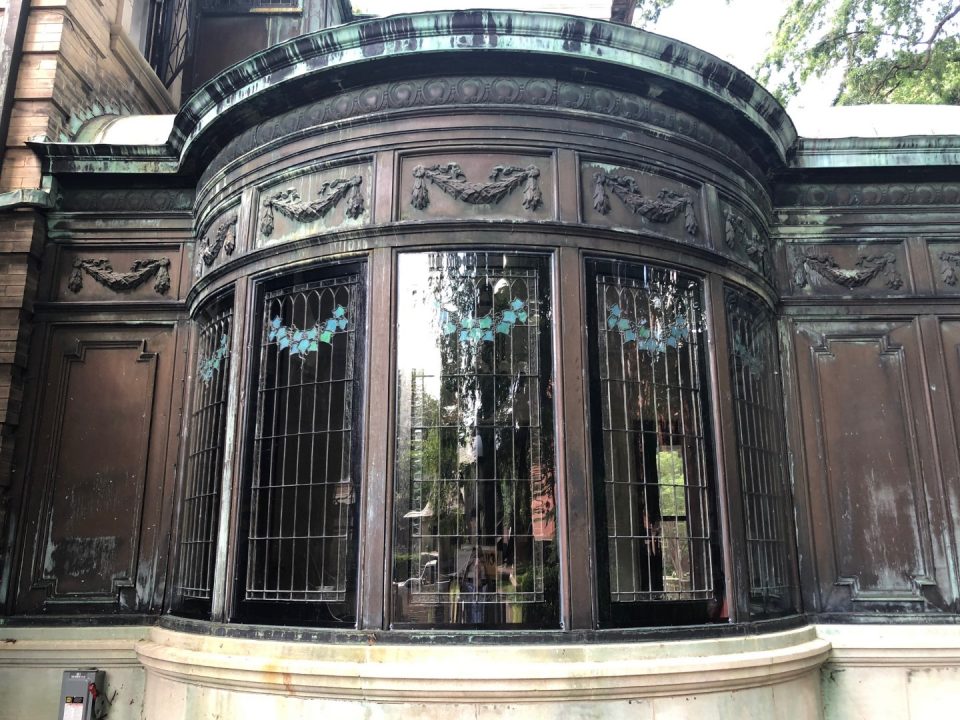
Every now and then we get a restoration project that involves curved windows.
This project was for a mansion in downtown Richmond. We were commissioned to remove the windows, dismantle, and rebuild them with new zinc. Our goal was to make the windows look as original as possible, especially the patina on the zinc.
We also added 1/4″ reinforcing bars on the horizontal lines, to take the pressure off expansion and contraction off of the zinc. The final phase was to install curved tempered glass on the outside.
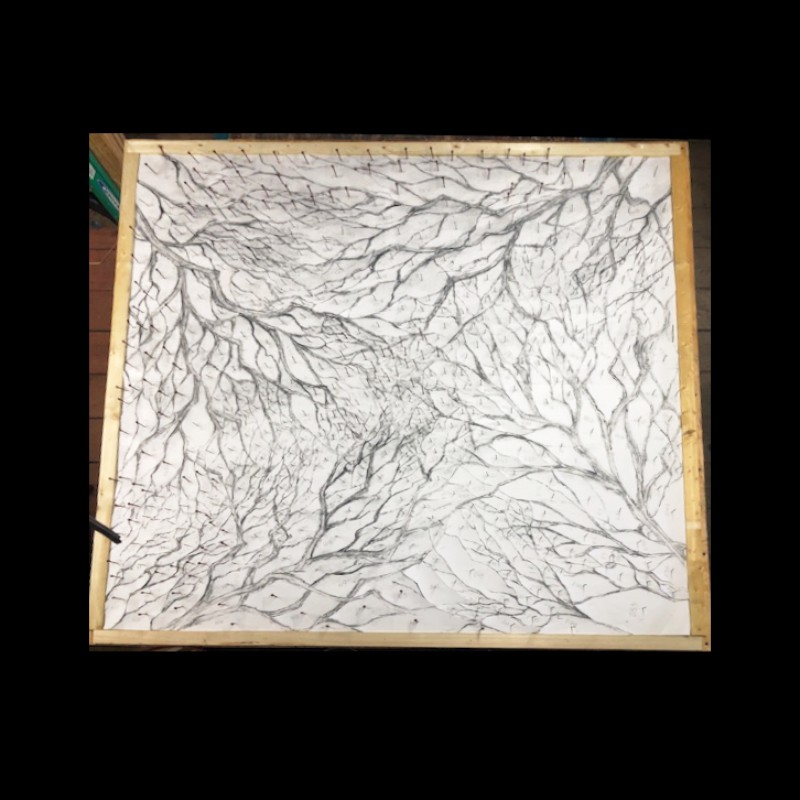
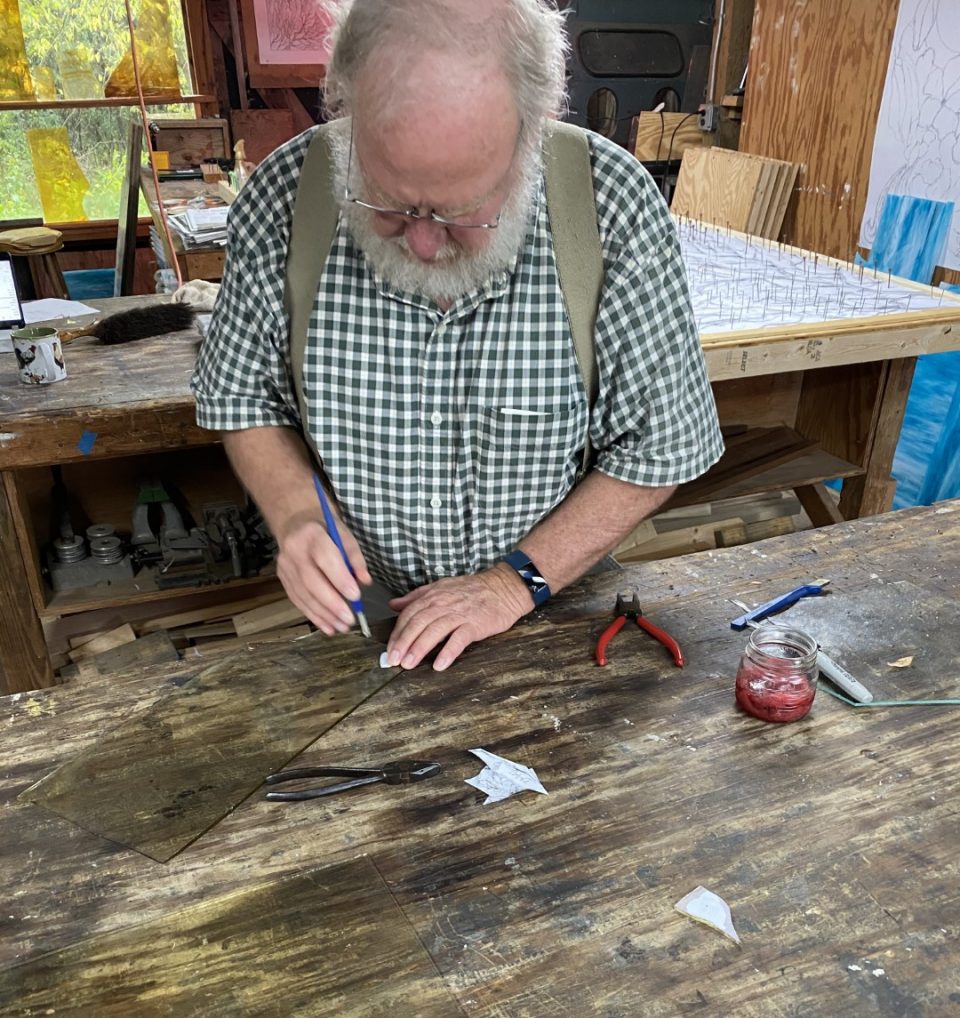
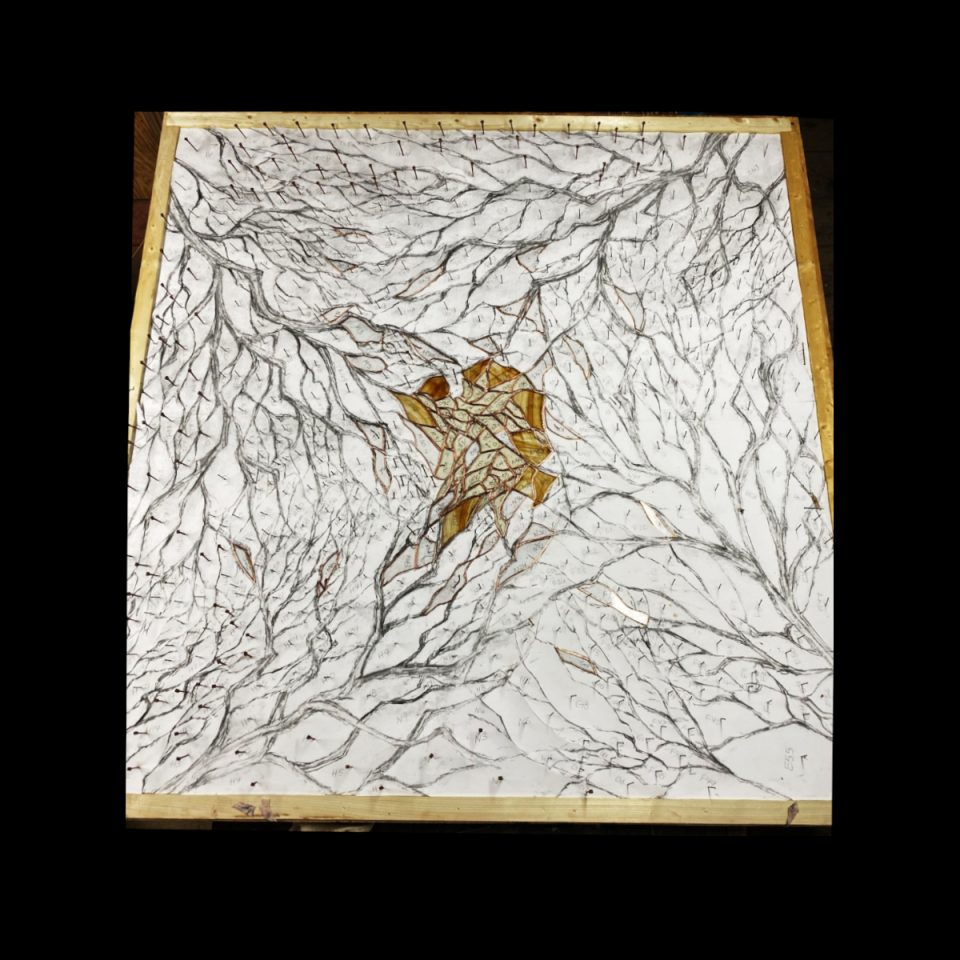
There are patterns…. and there are patterns.
Working on our laylight for a home in Potomac, Maryland. We’ll be posting updates as we go along.
It is difficult making a living as an independent artist/craftsperson. Some days, I feel like a corporation reduced down to one individual. It’s not only the expertise one must constantly develop to practice one’s art, but also all of the peripheral skills like marketing, selling, website development, purchasing materials, making presentations, taxes, insurance, social media, communication, organizational skills, and working with the people who help me produce my art.
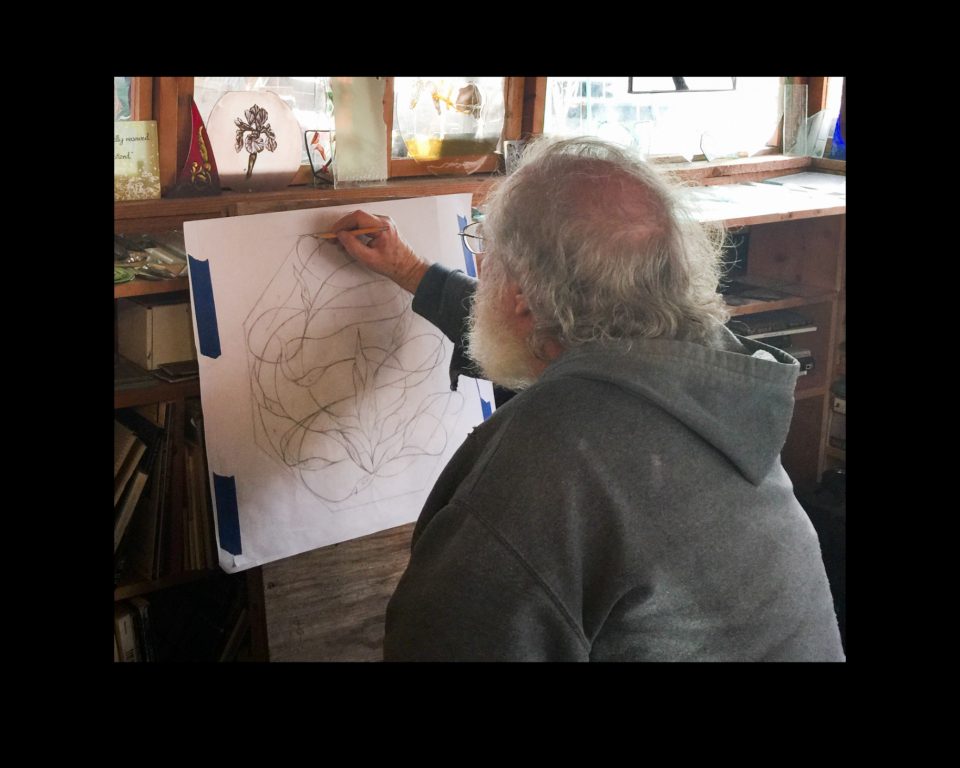
As I shuffle graphite around on paper, I often think of the connection between the pointed end of my pencil and the three-pound organ between my ears.
Billions of neurons, moving at 270 miles an hour, firing away while this pointed instrument records their “data.”
I believe it is important to take care of this “lighthouse.” Like the rest of our body, it only has so much strength and energy.
I have found, replacing needless stress with beauty that brings me pleasure seems to work.
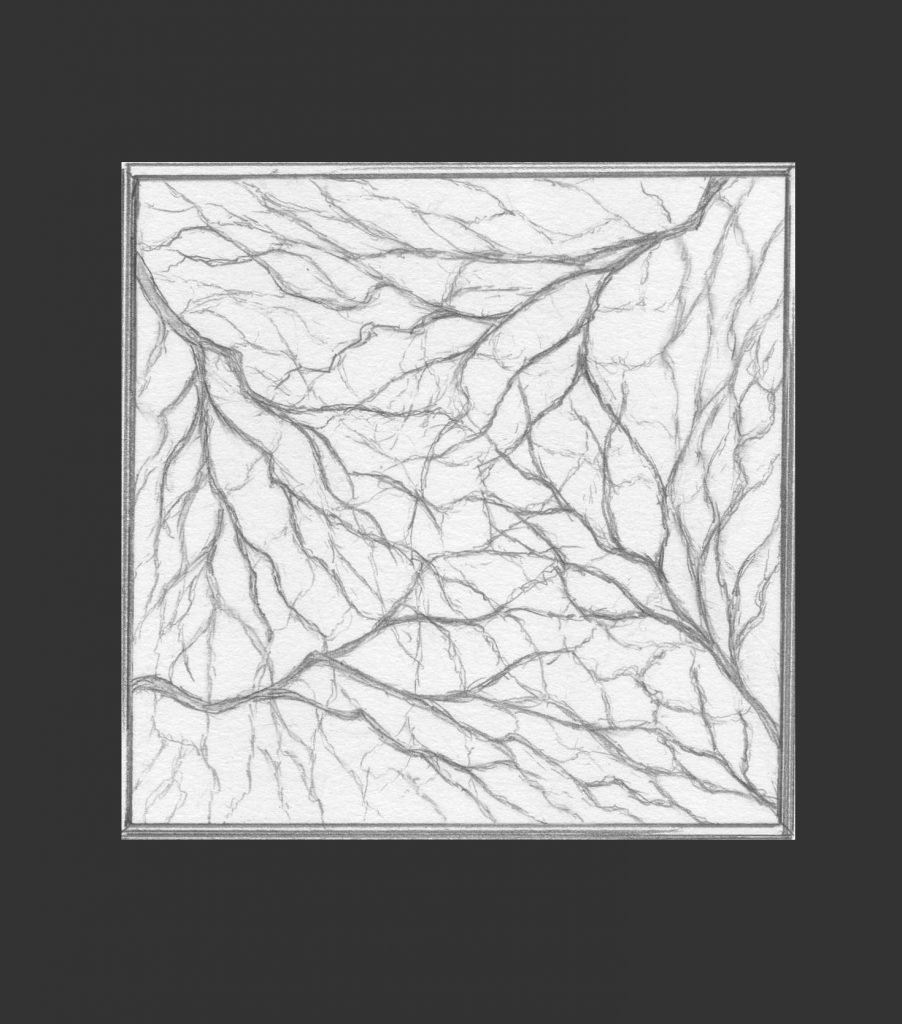
This sketch is a presentation drawing for a laylight we’re beginning to create for a home in Maryland. It represents the branches we will solder sculpture and patina to look realistic. After we finish the basic window we will attach a multitude of our flameworked leaves in various colors to represent early spring to early summer.
The laylight is five feet by five feet. One of the challenges we face is how to support it’s weight while horizontal. Part of the solution is to insert overlapping finishing nails in the spaces for the branches before we fill them with solder. On the larger branches, we will solder 1/8 x 3/8 inch reinforcing bars in the spaces.
If everything works as planned, our finish design will be uninterrupted by traditional structural bars.
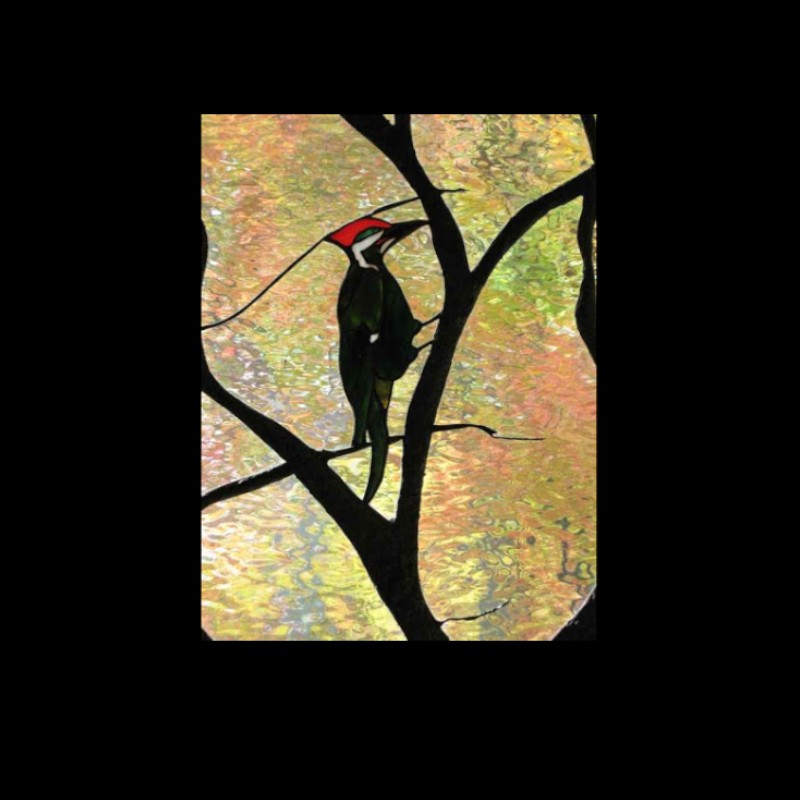
When I start a new project, I often have an overwhelming feeling of incompetence. How am I going to pull this off?
One of the ways I face this situation, besides walking around the shop, is looking through my portfolio and revisiting the volume and variety of what I’ve created over the last 48 years. This somehow seems to give me the push I need to start putting a few lines on paper.
This woodpecker is one of my favorite, inspiring confidence in my ability. It’s a reminder to me of the effort I went to, to create this fella’, and that I can do it again.
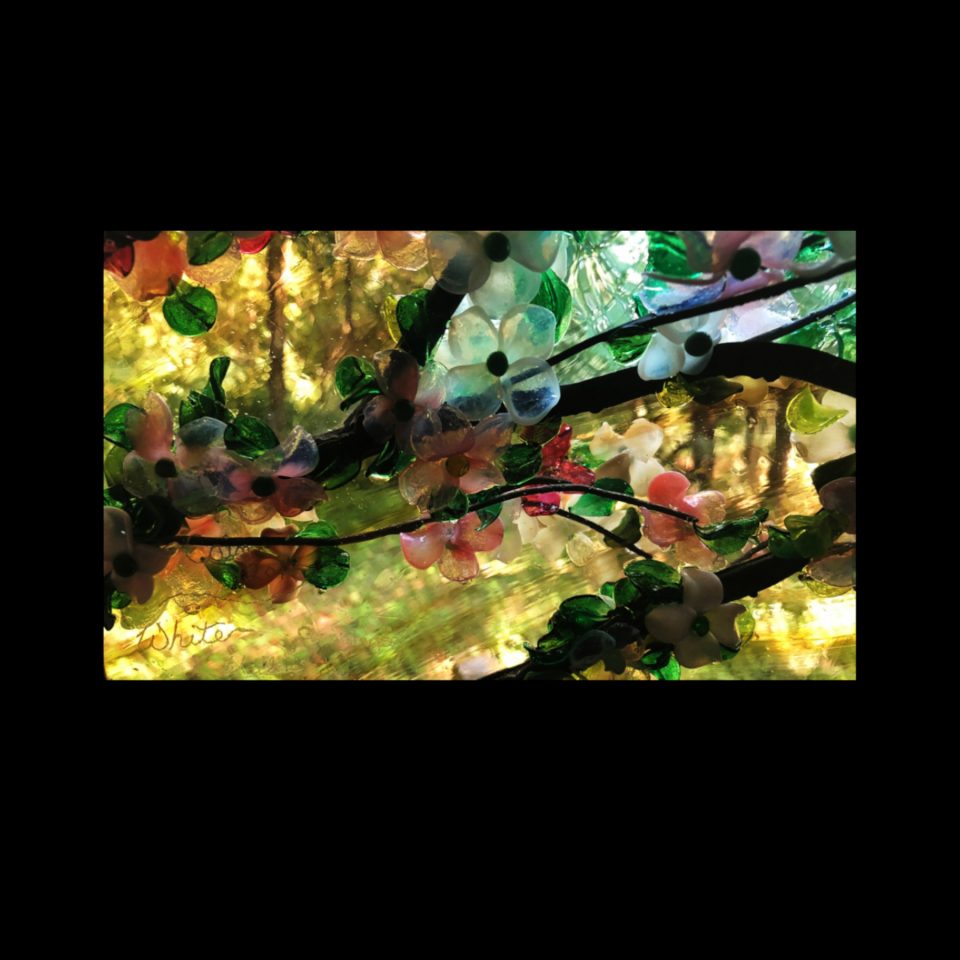
When we create our windows, we pay considerable attention to what is behind them. Vegetation generally works beautifully. A blue sky – not so much.
This blending of our art and nature is one of our favorites.

Much of what we’ve learned over the years has come from books and magazines. We’ve also spent a considerable amount of time walking around historic neighborhoods, especially at night, studying windows that were designed for the period.
However, we really enjoy it when we get a beauty like this in the shop to restore. Viewing the craftsmanship up close and studying the color scheme over a period of time, gives us an excellent opportunity to sharpen our skills.
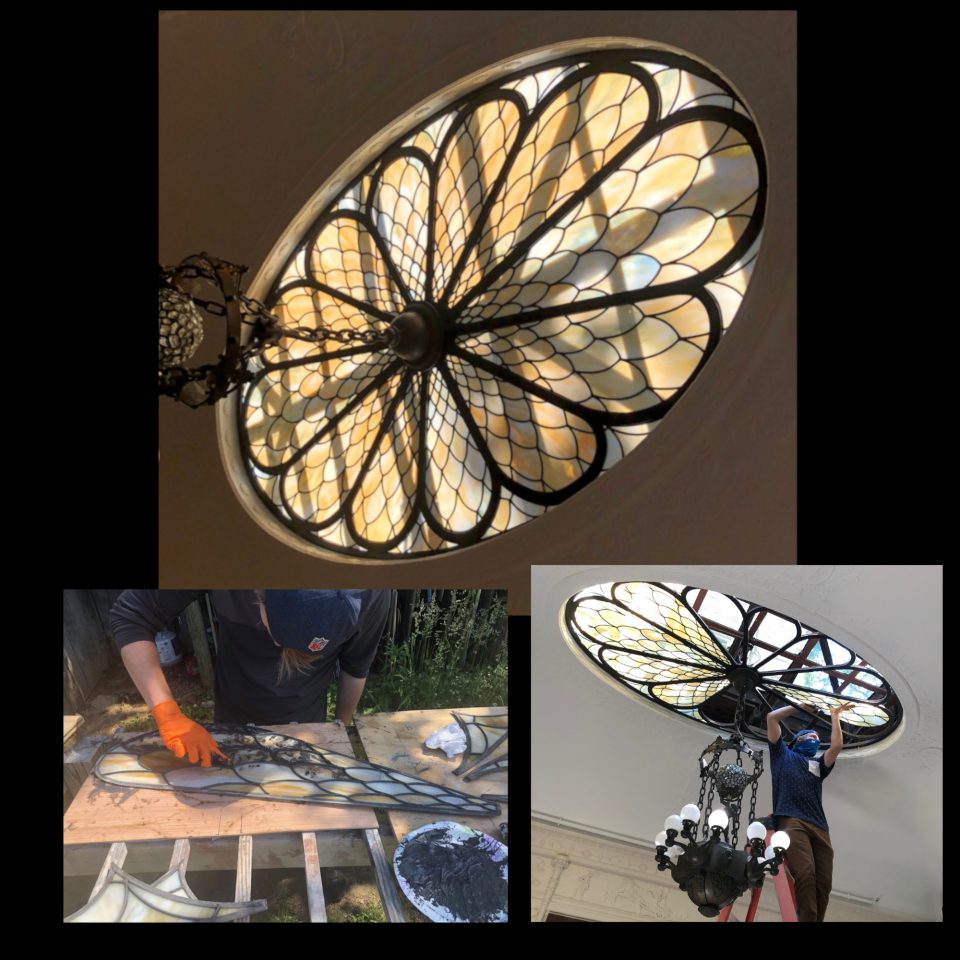
This is a skylight in a mansion in downtown Richmond that we refurbished. After flattening the bows, we applied our traditional glazing compound under all the zinc cames. Equal amounts of boiled and raw linseed oil, mixed with a handful of calcium carbonate, and a dash of lamp black.
Once the glazing has “cured” it will give the window much of its strength.
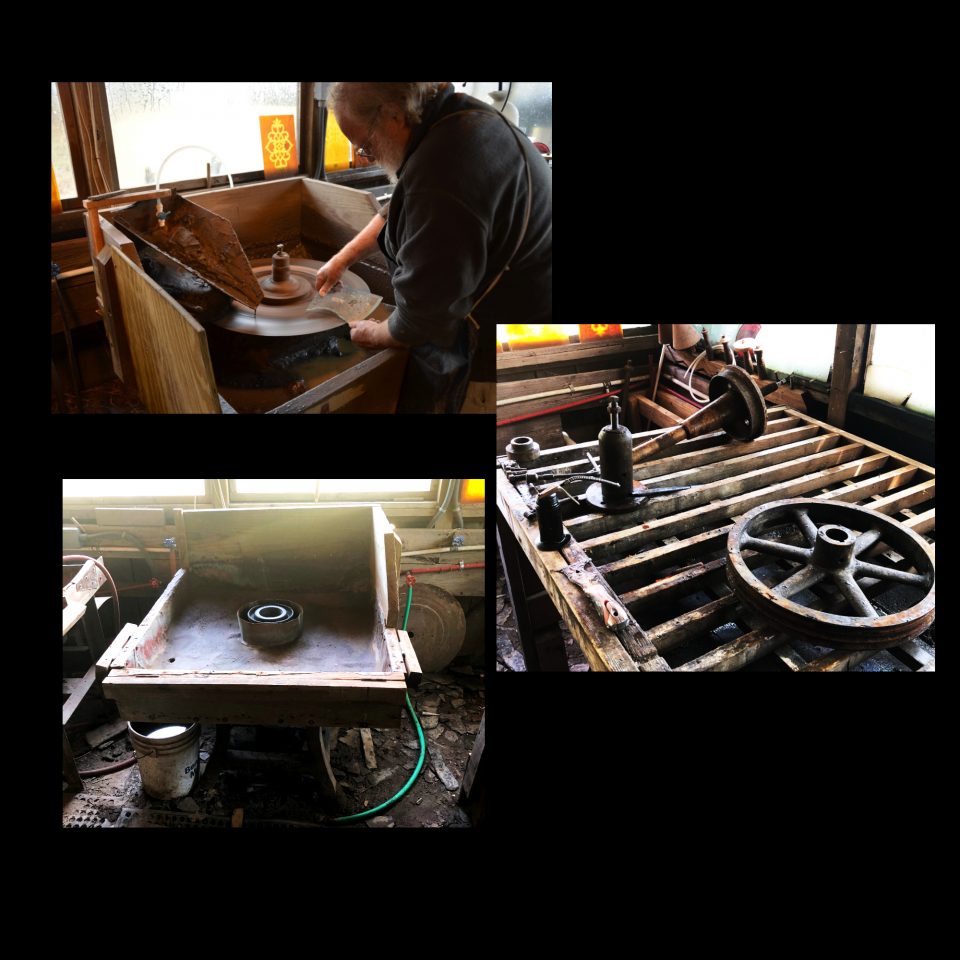
Have you ever wondered what’s on the inside of a 1915 Henry Lang beveling machine? Here you go.
Every 15 or 20 years, we break our machines down to check for internal wear and general maintenance.
We probably only use our beveling machines around 300 hours a year, so all we’ve ever had to replace are the belts and oil.
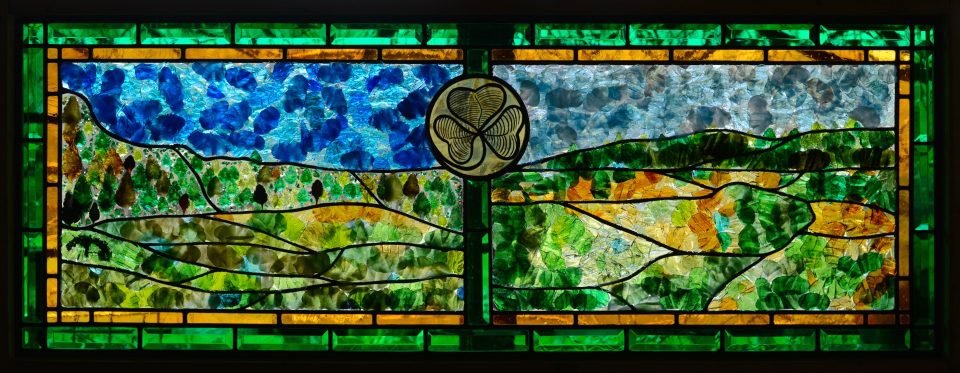
This is a recent commission to represent two Irish golf courses, one in Ireland, the other in New Kent County, Virginia.
By using our flameworking techniques, we wanted to give the effect of knife painting along with the play of light as expressed in impressionist painting.
I have never seen or heard of this process being used in stained glass before. It is certainly a milestone in my career.
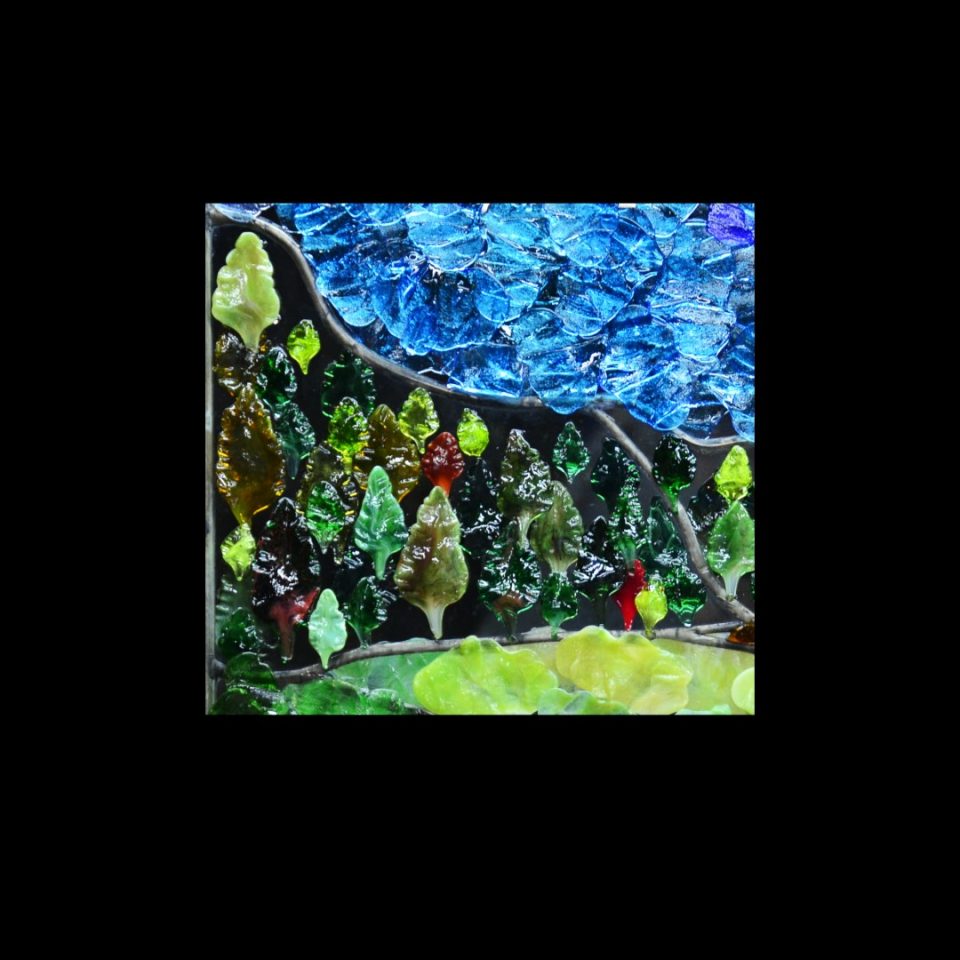
We’re trying a new concept here in our shop, to expand the range of our flameworking. A balance between knife painting and the role light plays in impressionist art.
Here is a small section, perhaps 1/10th of the window, to give you an idea. We’ll be posting the full window in a week or two.
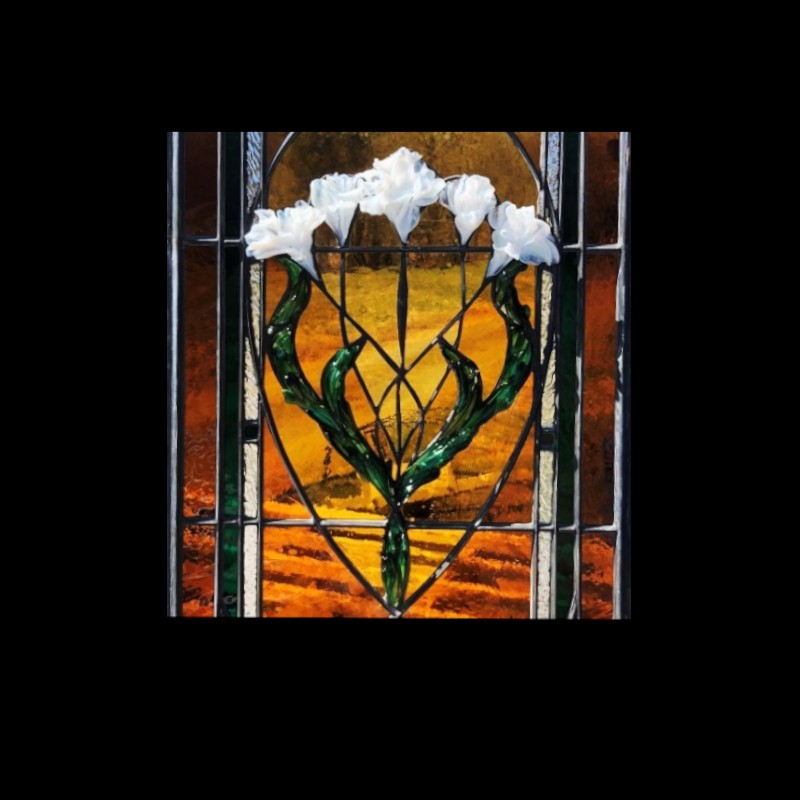
From time to time, we look back over our work for inspiration and encouragement to inspire us with our current projects.
This is definitely one of our favorites, not only in the skills necessary to execute it, but it’s aesthetics.

The family crest.
A front door window for one of the historic homes in Richmond, Virginia, created around 13 years ago.
Blown glass from Germany, painted, etched, and assembled with zinc.
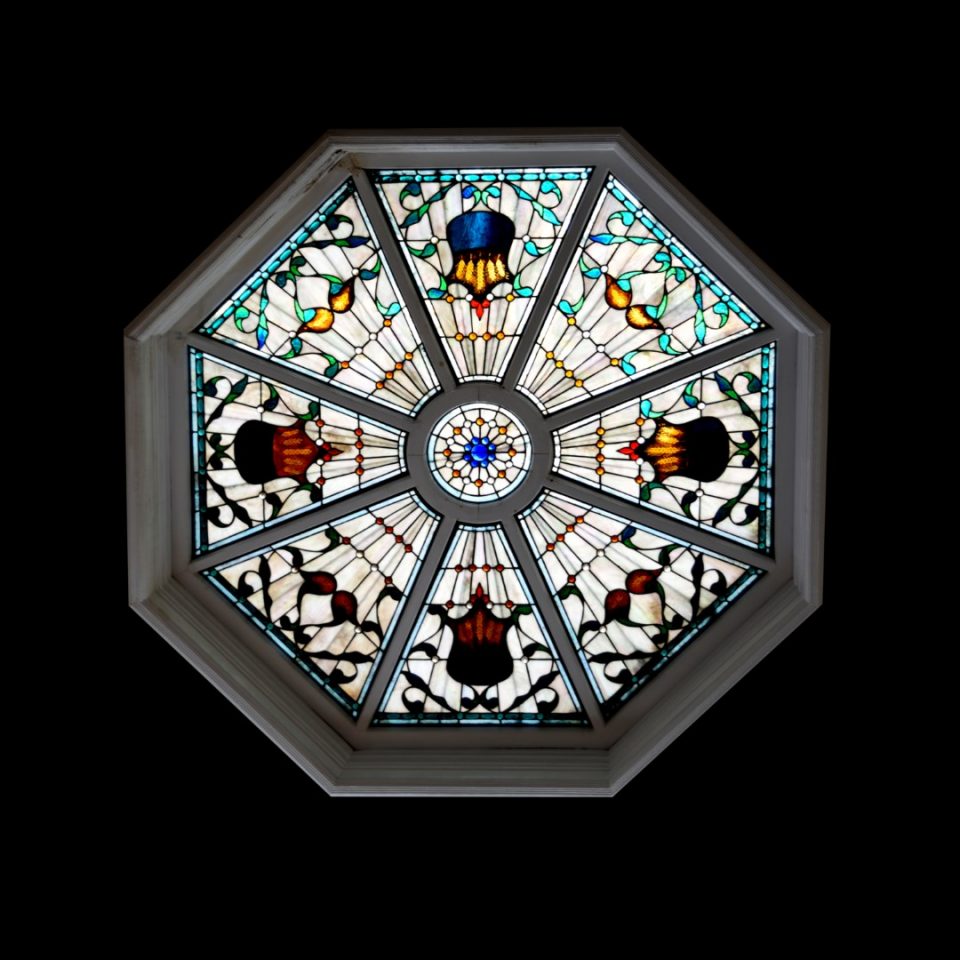
Richmond, Virginia is full of historical homes. I built this skylight in 2007, to replace the one that was beyond repair.
Skylights are such a rich focal point in architecture. This one is at the top of a 3-story staircase, which surrounded the view with beautiful millwork.

By beveling the background glass, a 1/8″ flash glass from Germany – gold on clear, I wanted to emphasize the light surrounding the floral image – halation.
I created this transom around 1990 for a beautiful old farmhouse. I feel fortunate to have spent my life creating thoughtful and beautiful accent pieces for architecture.
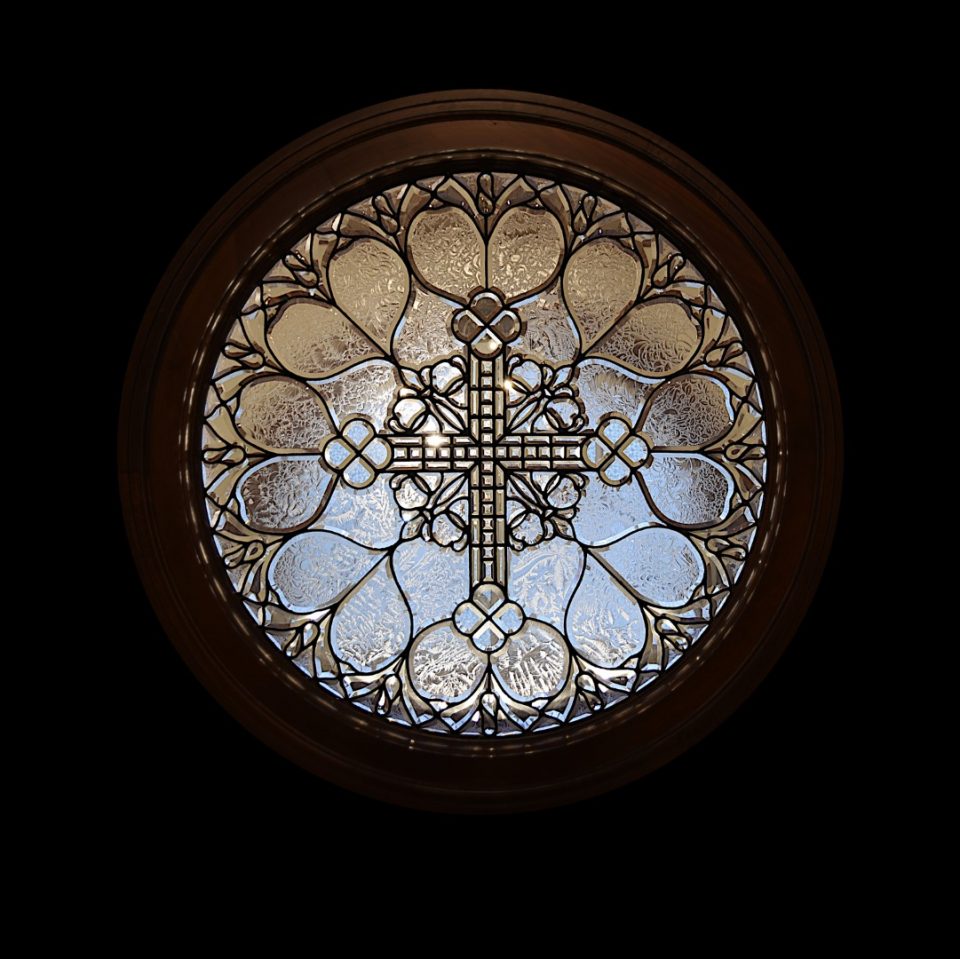
This is one of my favorite windows, created in 1986 for Grace Episcopal Church, Bremo Bluff, Virginia.
Starting with a blank piece of paper, a couple of #2’s, a big eraser and a boatload of perseverance, I wanted to bring something new to the world of sacred art.
Glue chipping glass for the background, beveling various thicknesses and angles, and with a multitude of tiny lights on the chandelier behind it, shimmering on the bevels as one walks around the sanctuary. It has often been referred to as our “spiritual window.”
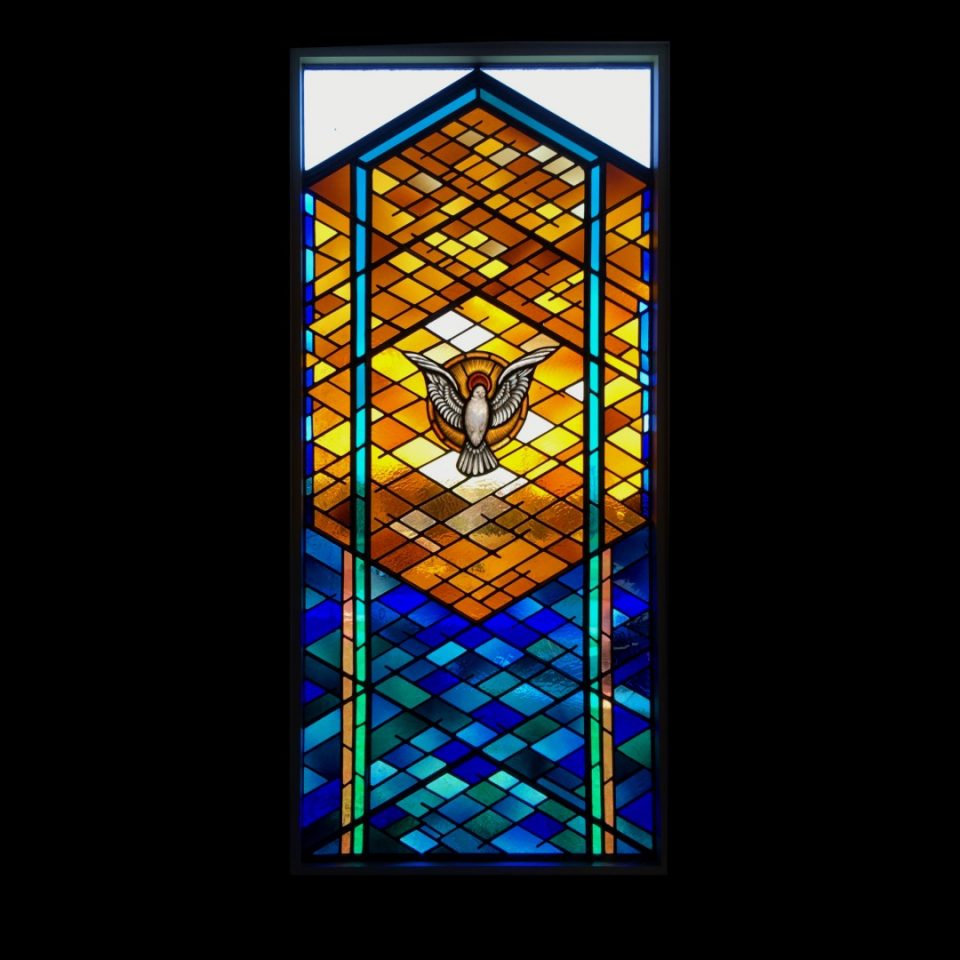
In 2014, we built a series of windows for Grace and Glory Lutheran Church in Palmyra, Virginia.
This is one of my favorites, created almost entirely with blown glass from the Blenko Glass Company in West Virginia.
I especially appreciate the wide range of color, as it changes throughout the day, continually capturing my interest.

One of three transom windows we just completed for a home in Warrenton, Virginia.
More and more, we are being commissioned to create windows that incorporate various techniques we have developed over the last 47 years.
We approach windows like this as little museums of our work.
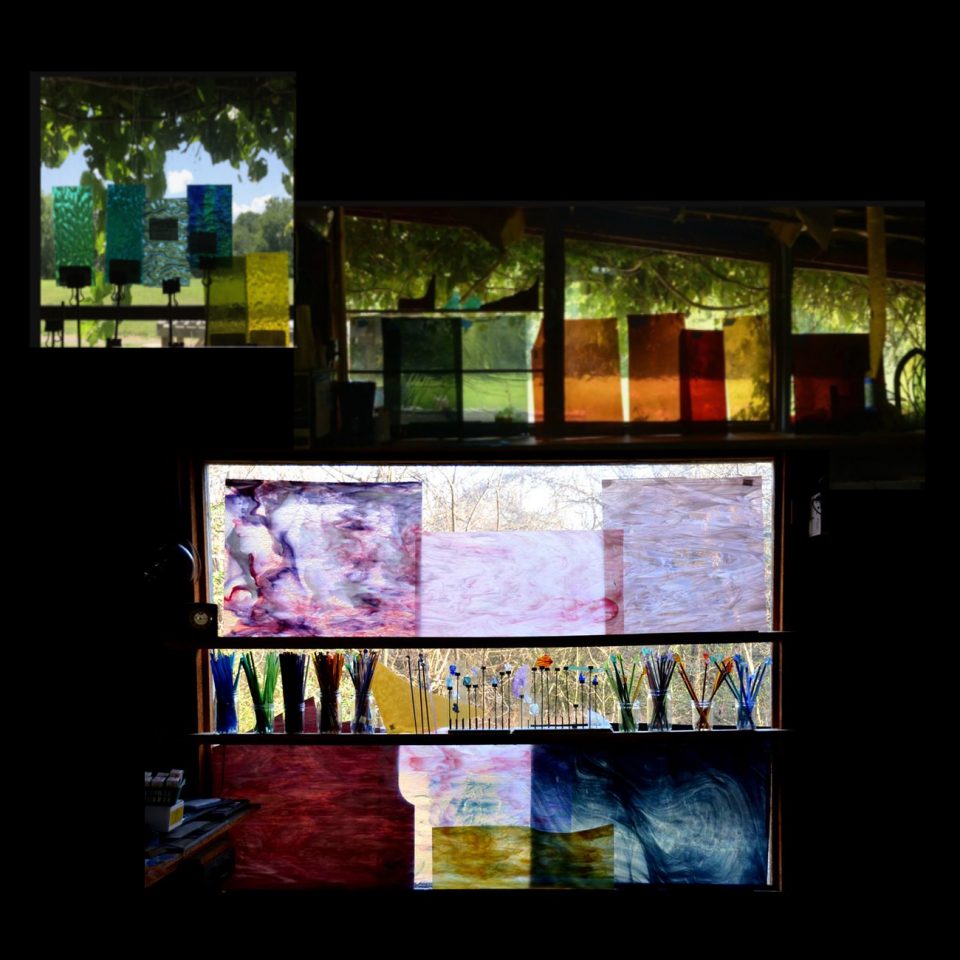
For me, color selection is a balance between intellect and emotions.
My studio is surrounded by windows on all sides. This gives it a nice balance of light that allows my eyes to relax, allowing me to observe a wide range of colors, comfortably. We use the windows facing North, for consistent light, and South for a wider range of light throughout the day. Both windows have trees and sky behind them, which greatly influences the subtleties of stained glass.
Color selection is one of the first things I start when undertaking a project. It is important to “live” with the selections to really know how they will respond to light over time.
Thinking, observing and feeling my way through this process is a way of life, as I move around my workplace, pausing to reflect on the glass we have arranged in our windows.
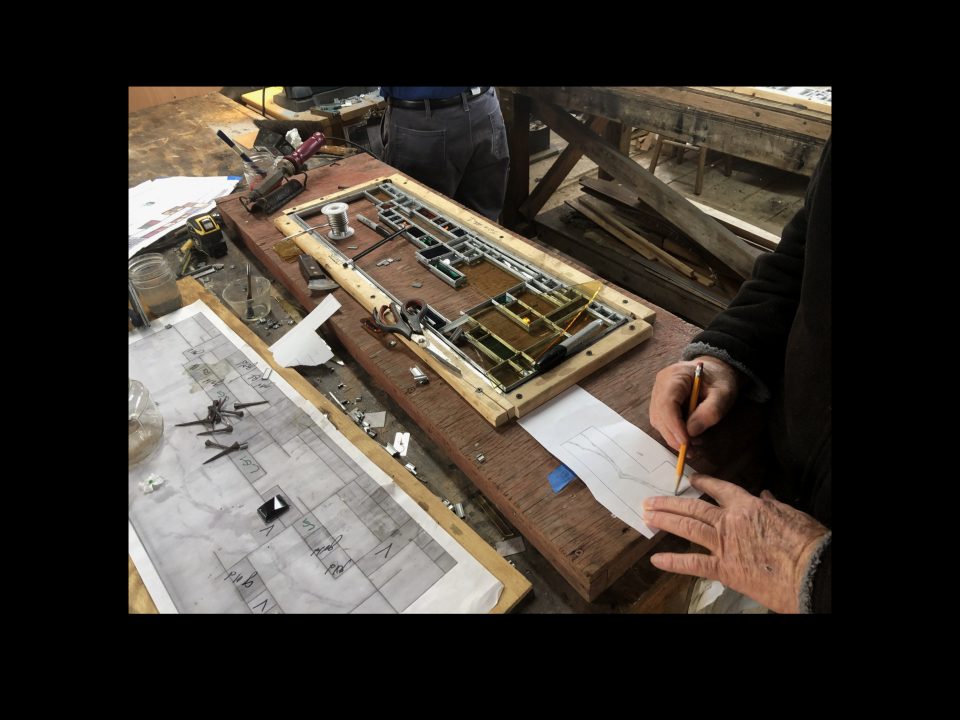
What I like most about being an artist/craftsman, is my involvement in the creative process from start to finish.
The evolution of an object brings new insight as materials replace the original drawing. Depth, line, and color stimulate my mind to push forward, analogizing other possibilities. It’s those bursts of insights when I’m wide awake at 2:00am, stepping out of the shower, driving down the road, that I have some of my most pleasant moments.
I’m from the ’60s and ’70s, when one was encouraged to self-actualize. To be inwardly driven to be all one was capable of. To achieve fulfillment in life from one’s personal development.
So every day, I push the bounds of my art. Drawing, selecting, rarely totally satisfied but finally saying, that’s it.
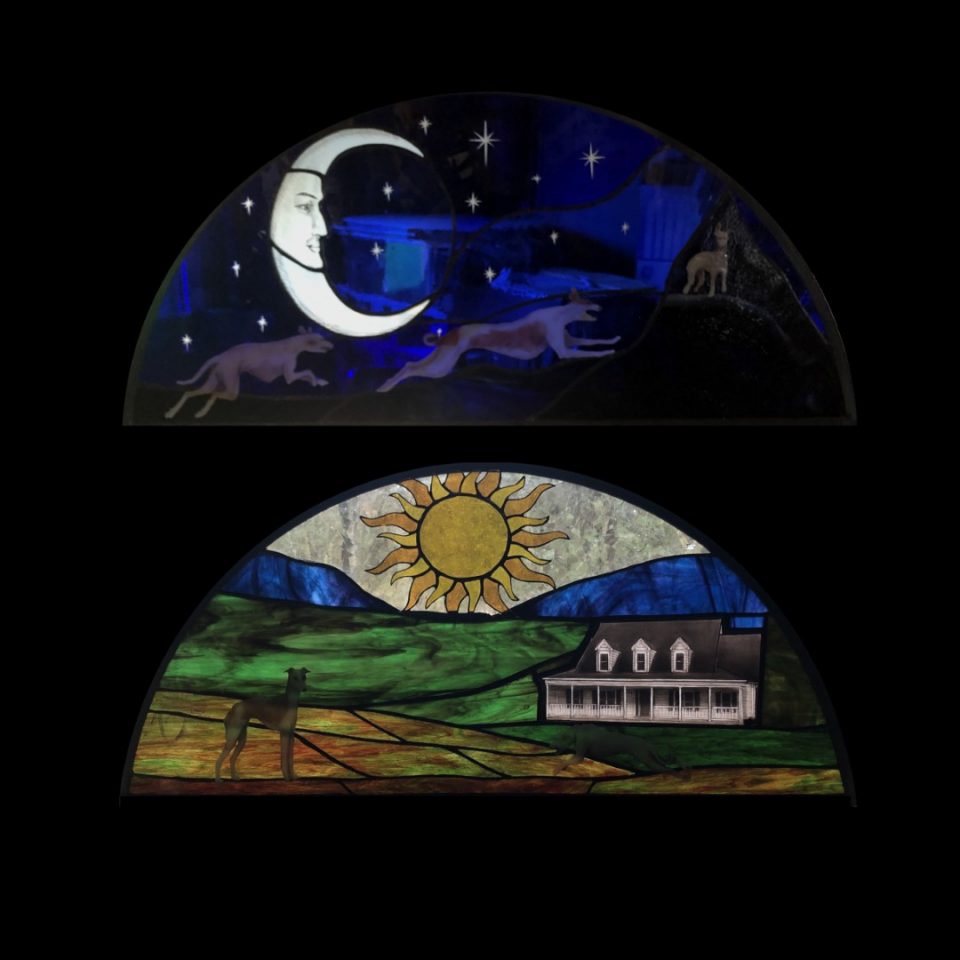
Two windows we just completed for a couple who wanted to feature their whippits, greyhounds, home, and their beautiful setting between mountain ranges.
This was a great exercise in the push-pull of reflective and translucent glass, creating windows that changed throughout the day and evening.
We commissioned the painting to Daniel White, who always does a fabulous job.
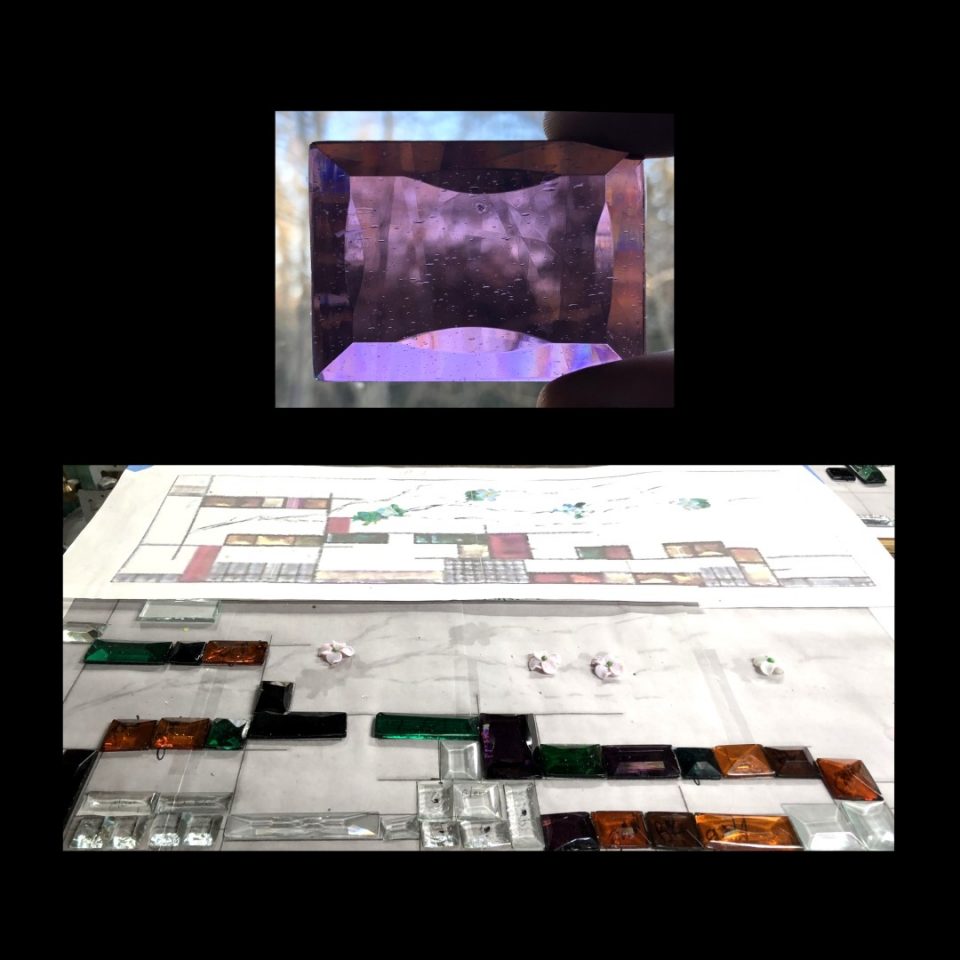
One of our current projects for 3 transom windows which highlight the combination of our beveling, with its various thicknesses of glass and angles, and laminating it with colored translucent glass.
After 47 years, it is so nice to create windows that have evolved from all those years of “thinking-and-doing.”
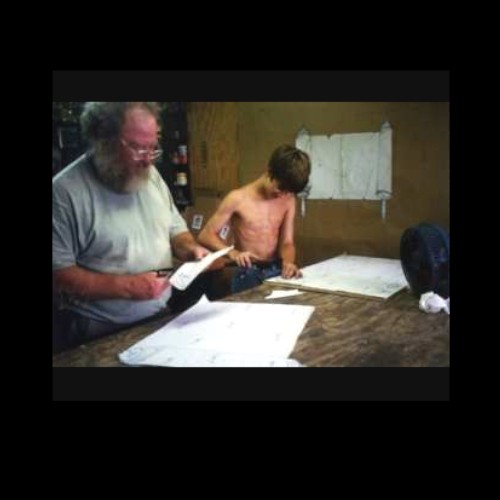
When our children were growing up, there are 5 of them, they would all work with me in the shop during the summers and some weekends.
My father took me to work with him when I was their age. When I look back on those days, they were some of the most important experiences I’ve had in life.
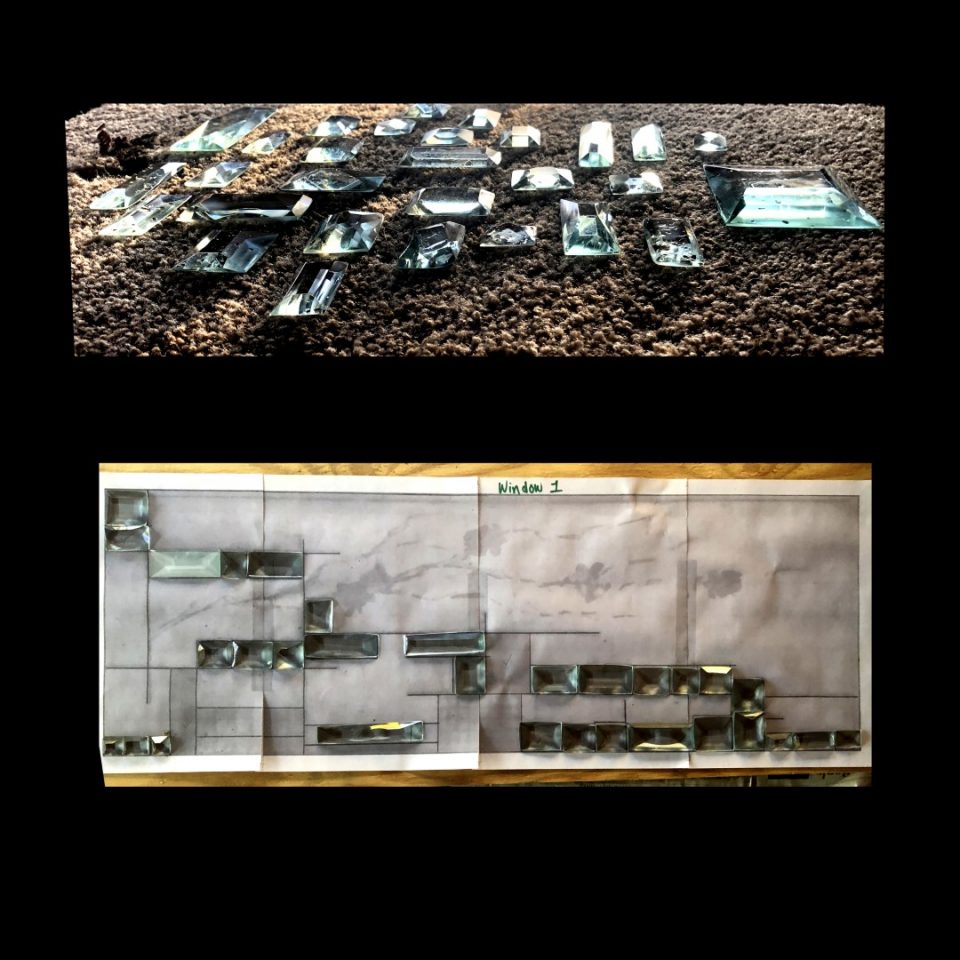
One of our current projects involves creative beveling. We are using our imagination to create just about every angle we can, on several different thicknesses of glass.
The next stage is to laminate various colors of translucent glass, to give the bevels a jewel-like quality.
When we create windows of this nature, we like to think of them as little museums of our work.

In 1990, I was in a partnership with Geraldine Powers. Geraldine would design and I would build.
We created this dome for the Jefferson-Pilot Building in Winston-Salem, North Carolina.
This 12 foot-wide dome was built like a drop ceiling. A steel framework was created and the stained glass windows were inserted into the open spaces. We gently curved the window at the lead joints to fit the dome and reinforced the curvature with steel reinforcing bars.
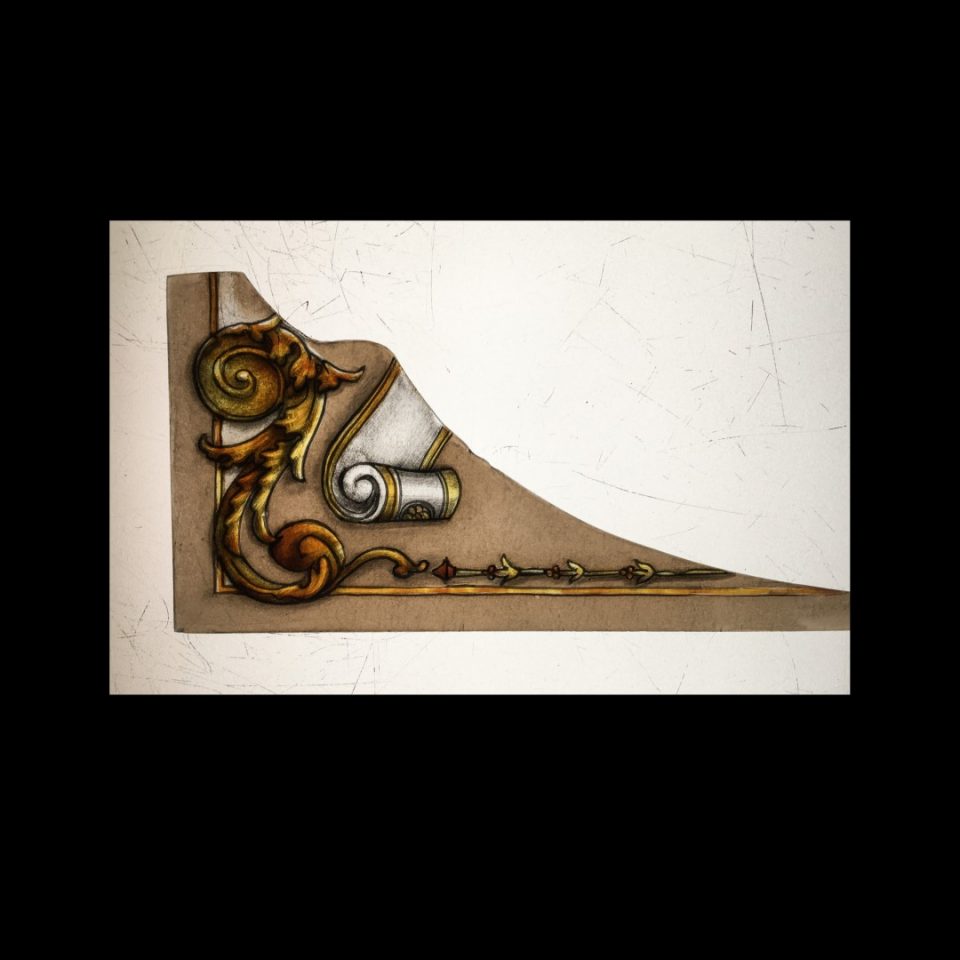
Daniel White, one of my step-sons, does all the painting for our studio. This is a piece he reproduced for the restoration of a 100-year-old window.The color selection, application of paint, along with the various firing temperatures makes for a very complicated process, which Daniel excels in.
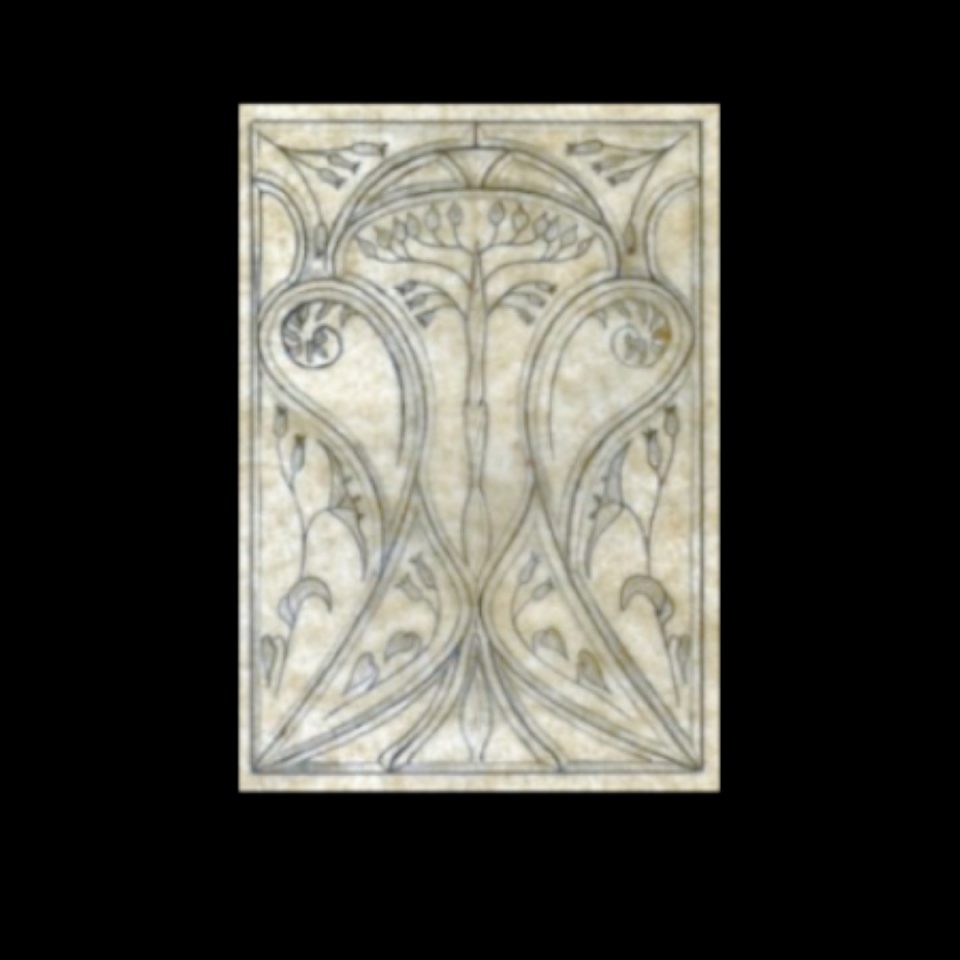
This is an idea sketch I created around 30 years ago for a front door. I had planned on beveling 3/8″ thick glass, into which I would carve the floral design and assemble with heavy zinc came.
It’s still sitting in my portfolio and ready to be refined and brought to life.
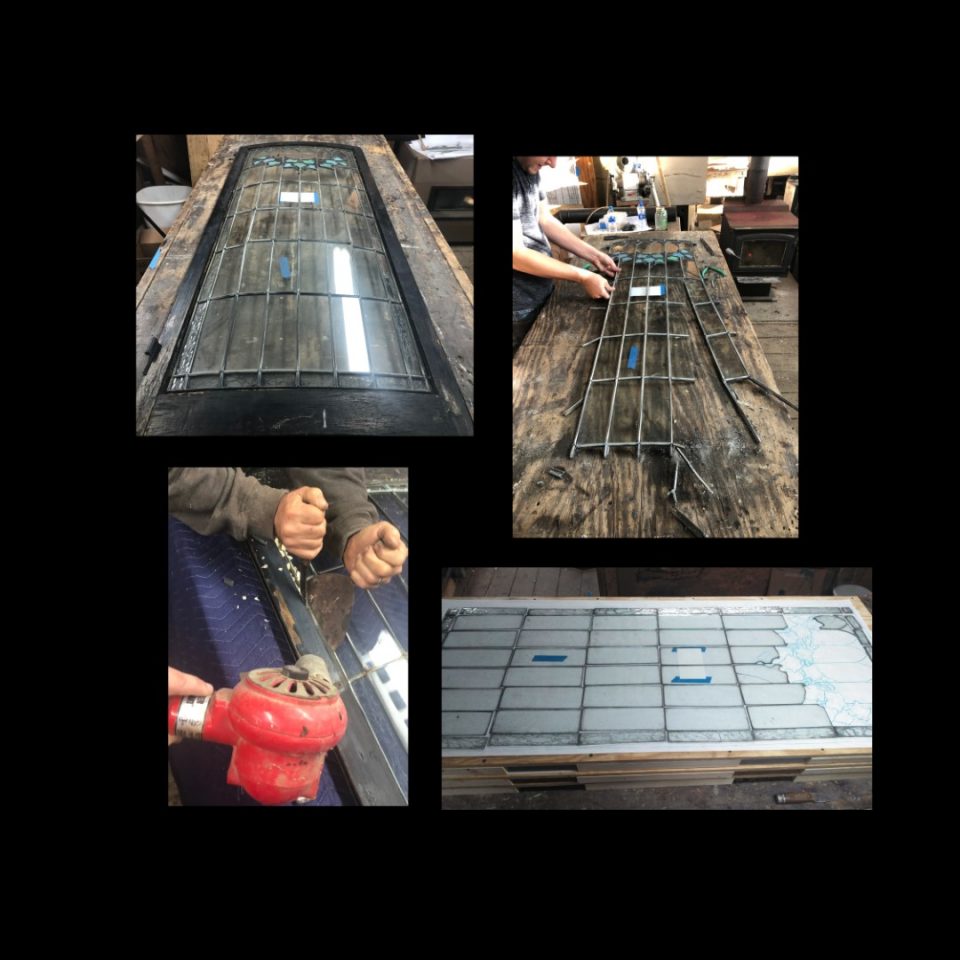
Today is the beginning of the restoration of 10 curved windows in a historic home in Richmond, VA.
We will disassemble the windows and rebuild them with new zinc, along with the traditional cleaning, puttying, patinaed, and reglazing.
There is always a lot to learn through our restoration projects and we enjoy the break from our more creative projects.

Zinc came is a challenging material to work with, but what I like are the crisp, straight lines and smooth curves. It’s also especially nice for beveled glass, which is thicker than the typical stained glass windows and requires more structural strength.
It also patinas down nicely, so it doesn’t compete with the glass.

An entryway for a home in Richmond, VA that I created around 1999.
A stylized peacock design with many variations that are popular throughout the South.
This one is my favorite.

This was a special project in which a single mom and her two teenage sons came to us with an idea for their new home.
In the daytime, it’s barely noticeable, but at night it comes alive.
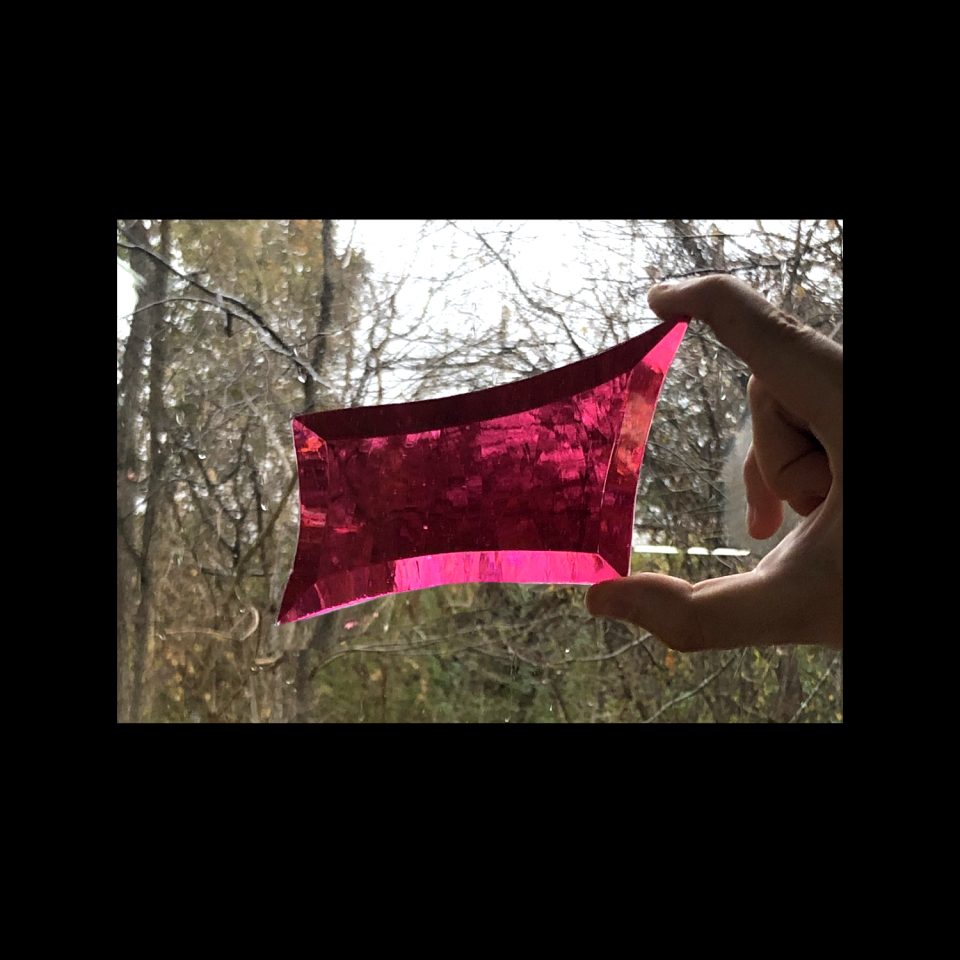
A study for one of our current projects.
This is a process where we combine our hand beveling with blown glass from Germany. We can actually silicone them together, much like your windshield.
They say it will last forever.
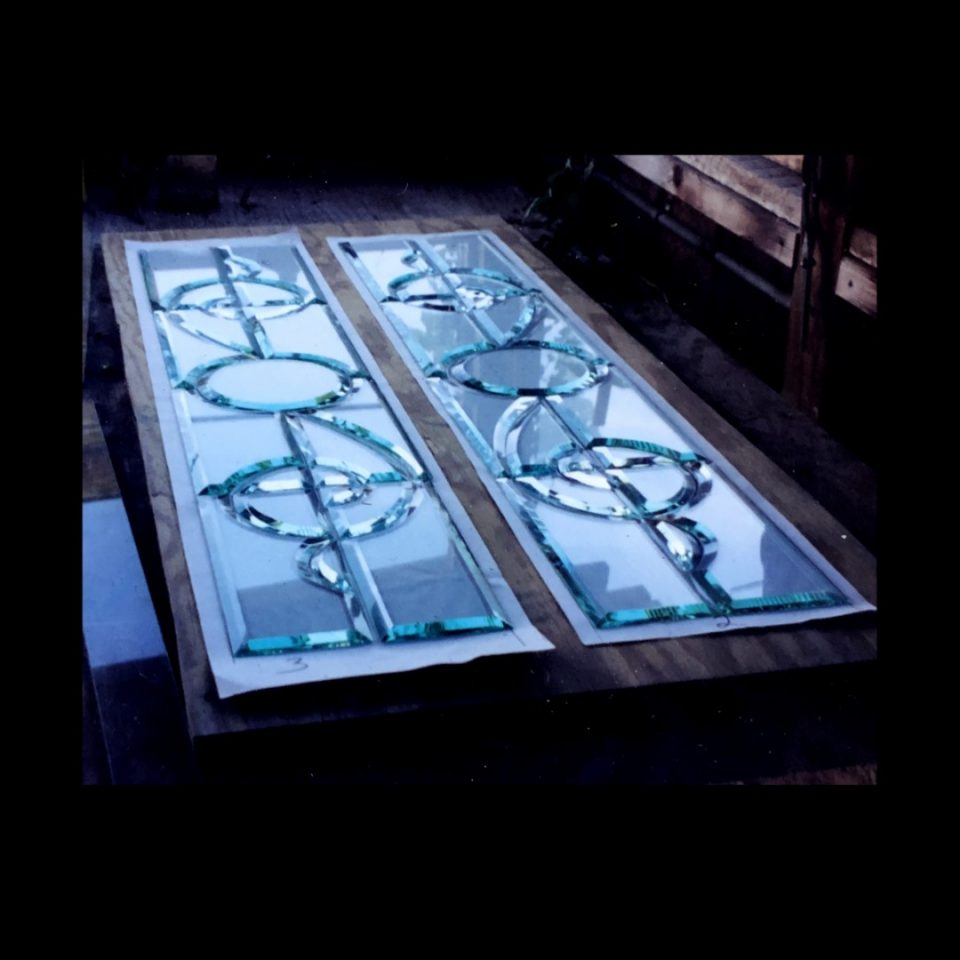
This is a progress shot of two sidelights we beveled around 30 years ago. After the final inspection, and before we begin to zinc them together.
There was a time, many years ago, when we would take progress photographs and mail them to our clients. Our thought was, that they would have these around their home to show their neighbors and friends – a form of our early marketing.
Today, of course, we just email them.

This is a mirror I created around 20 years ago.
I started by beveling each piece of glass at a very steep angle to capture the light of the sconces on each side.
By contaminating the silver, I was able to create an antique effect that complemented the patina on the sculptured tree.
I really like the shadows and the moving light as one walks through the narrow hallway, creating a romantic mood in an intimate space.
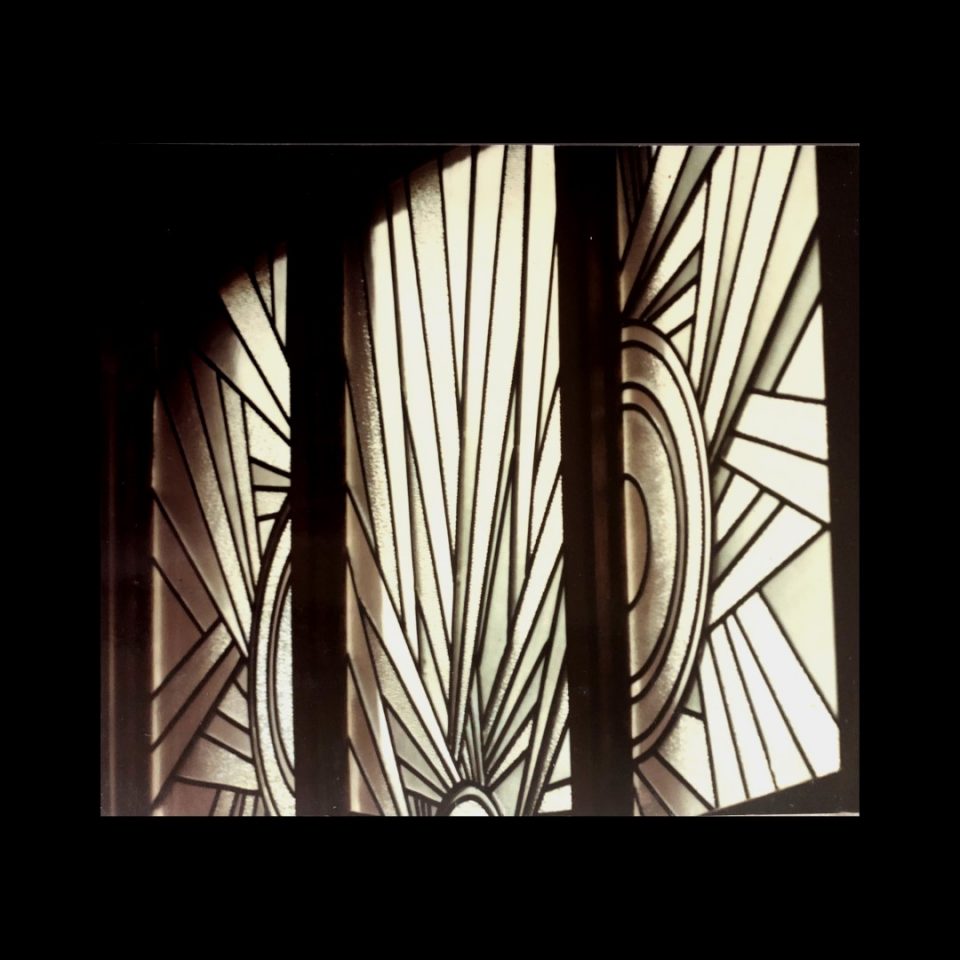
Circa 1980, back when I created an Art Deco series for the 5th Avenue Restaurant across from Pleasant’s Hardware in Richmond, VA. We found it interesting the effect we were able to create with different textures of clear glass.

This beveled glass window was created in 1988 for the entrance door of the Fork Union Military Academy’s Alumni House. Most of our beveling is done on 1/4″ or 5/16″ glass, like the windows you see along Monument Avenue in Richmond, VA. This was one of our first windows using 3/8″ glass. We started using the thicker glass so our windows would, “hold their own” when surrounded by heavy trim molding. The areas that appear dark are actually emerald green glass.